The Australian Dollar and the Exchange Rates Assignment
VerifiedAdded on 2021/05/31
|33
|5865
|40
AI Summary
Contribute Materials
Your contribution can guide someone’s learning journey. Share your
documents today.

Running Head: THE AUSTRALIAN DOLLAR AND THE EXCHANGE RATES
THE AUSTRALIAN DOLLAR AND THE EXCHANGE RATES
Name of the student
Instructor
Institution
Course
Date
THE AUSTRALIAN DOLLAR AND THE EXCHANGE RATES
Name of the student
Instructor
Institution
Course
Date
Secure Best Marks with AI Grader
Need help grading? Try our AI Grader for instant feedback on your assignments.
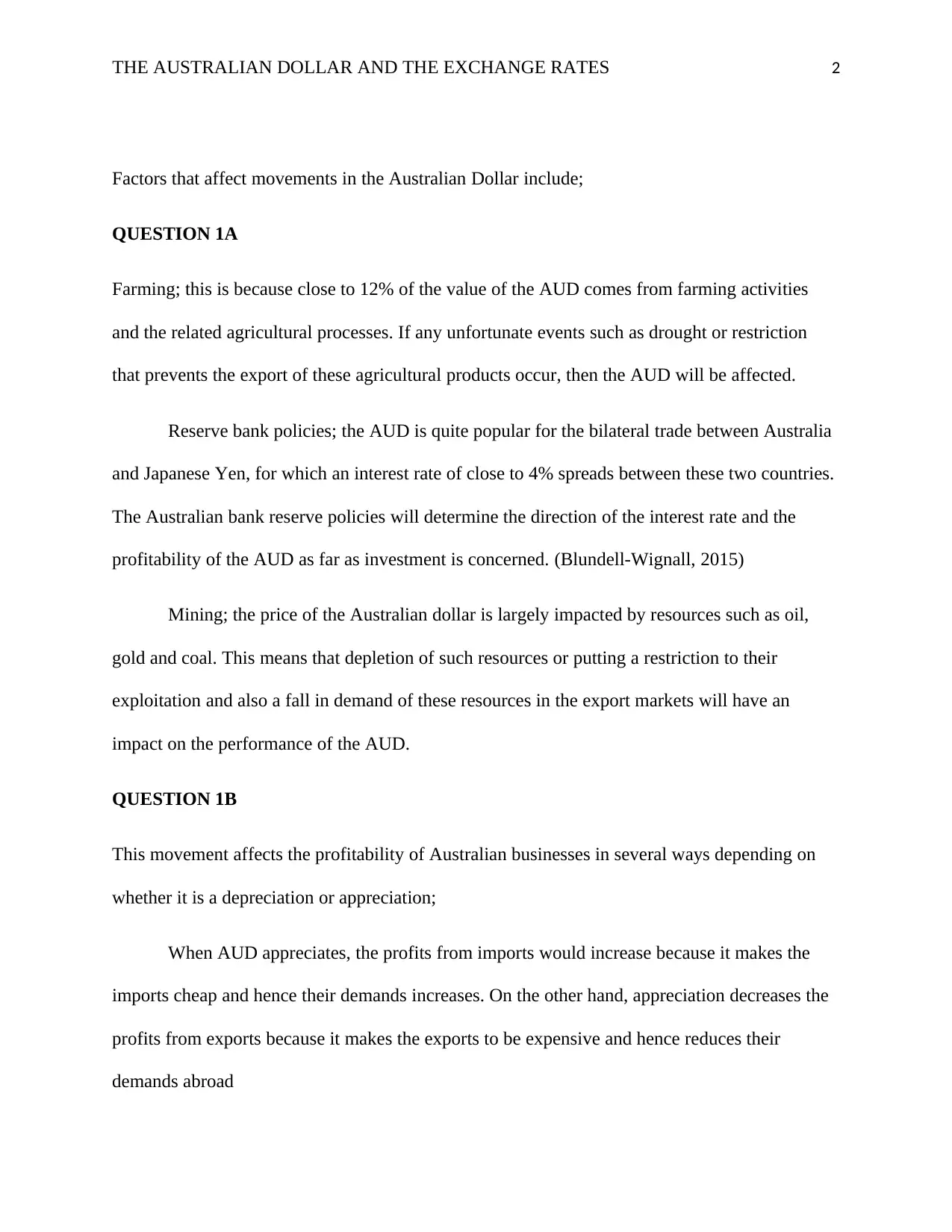
THE AUSTRALIAN DOLLAR AND THE EXCHANGE RATES 2
Factors that affect movements in the Australian Dollar include;
QUESTION 1A
Farming; this is because close to 12% of the value of the AUD comes from farming activities
and the related agricultural processes. If any unfortunate events such as drought or restriction
that prevents the export of these agricultural products occur, then the AUD will be affected.
Reserve bank policies; the AUD is quite popular for the bilateral trade between Australia
and Japanese Yen, for which an interest rate of close to 4% spreads between these two countries.
The Australian bank reserve policies will determine the direction of the interest rate and the
profitability of the AUD as far as investment is concerned. (Blundell-Wignall, 2015)
Mining; the price of the Australian dollar is largely impacted by resources such as oil,
gold and coal. This means that depletion of such resources or putting a restriction to their
exploitation and also a fall in demand of these resources in the export markets will have an
impact on the performance of the AUD.
QUESTION 1B
This movement affects the profitability of Australian businesses in several ways depending on
whether it is a depreciation or appreciation;
When AUD appreciates, the profits from imports would increase because it makes the
imports cheap and hence their demands increases. On the other hand, appreciation decreases the
profits from exports because it makes the exports to be expensive and hence reduces their
demands abroad
Factors that affect movements in the Australian Dollar include;
QUESTION 1A
Farming; this is because close to 12% of the value of the AUD comes from farming activities
and the related agricultural processes. If any unfortunate events such as drought or restriction
that prevents the export of these agricultural products occur, then the AUD will be affected.
Reserve bank policies; the AUD is quite popular for the bilateral trade between Australia
and Japanese Yen, for which an interest rate of close to 4% spreads between these two countries.
The Australian bank reserve policies will determine the direction of the interest rate and the
profitability of the AUD as far as investment is concerned. (Blundell-Wignall, 2015)
Mining; the price of the Australian dollar is largely impacted by resources such as oil,
gold and coal. This means that depletion of such resources or putting a restriction to their
exploitation and also a fall in demand of these resources in the export markets will have an
impact on the performance of the AUD.
QUESTION 1B
This movement affects the profitability of Australian businesses in several ways depending on
whether it is a depreciation or appreciation;
When AUD appreciates, the profits from imports would increase because it makes the
imports cheap and hence their demands increases. On the other hand, appreciation decreases the
profits from exports because it makes the exports to be expensive and hence reduces their
demands abroad
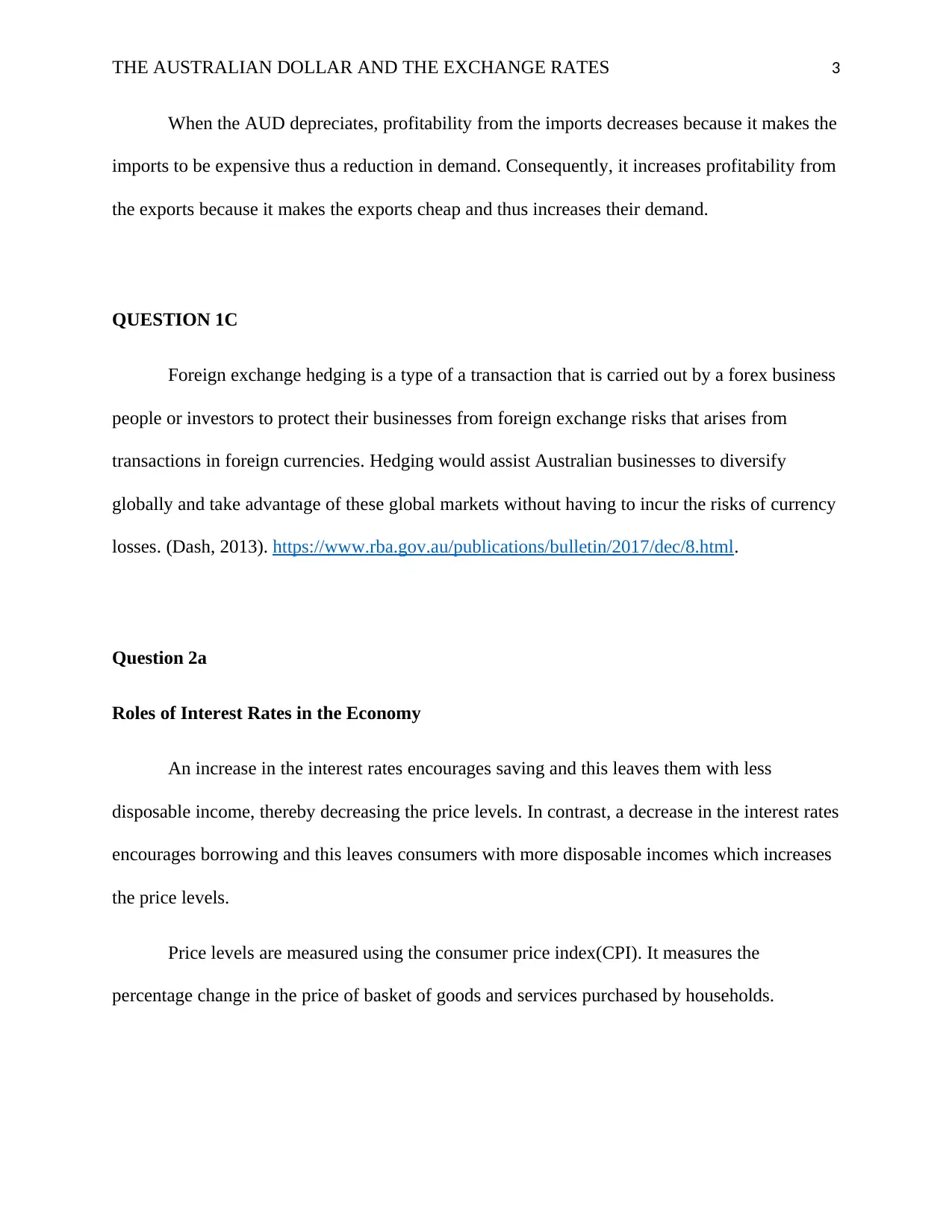
THE AUSTRALIAN DOLLAR AND THE EXCHANGE RATES 3
When the AUD depreciates, profitability from the imports decreases because it makes the
imports to be expensive thus a reduction in demand. Consequently, it increases profitability from
the exports because it makes the exports cheap and thus increases their demand.
QUESTION 1C
Foreign exchange hedging is a type of a transaction that is carried out by a forex business
people or investors to protect their businesses from foreign exchange risks that arises from
transactions in foreign currencies. Hedging would assist Australian businesses to diversify
globally and take advantage of these global markets without having to incur the risks of currency
losses. (Dash, 2013). https://www.rba.gov.au/publications/bulletin/2017/dec/8.html.
Question 2a
Roles of Interest Rates in the Economy
An increase in the interest rates encourages saving and this leaves them with less
disposable income, thereby decreasing the price levels. In contrast, a decrease in the interest rates
encourages borrowing and this leaves consumers with more disposable incomes which increases
the price levels.
Price levels are measured using the consumer price index(CPI). It measures the
percentage change in the price of basket of goods and services purchased by households.
When the AUD depreciates, profitability from the imports decreases because it makes the
imports to be expensive thus a reduction in demand. Consequently, it increases profitability from
the exports because it makes the exports cheap and thus increases their demand.
QUESTION 1C
Foreign exchange hedging is a type of a transaction that is carried out by a forex business
people or investors to protect their businesses from foreign exchange risks that arises from
transactions in foreign currencies. Hedging would assist Australian businesses to diversify
globally and take advantage of these global markets without having to incur the risks of currency
losses. (Dash, 2013). https://www.rba.gov.au/publications/bulletin/2017/dec/8.html.
Question 2a
Roles of Interest Rates in the Economy
An increase in the interest rates encourages saving and this leaves them with less
disposable income, thereby decreasing the price levels. In contrast, a decrease in the interest rates
encourages borrowing and this leaves consumers with more disposable incomes which increases
the price levels.
Price levels are measured using the consumer price index(CPI). It measures the
percentage change in the price of basket of goods and services purchased by households.
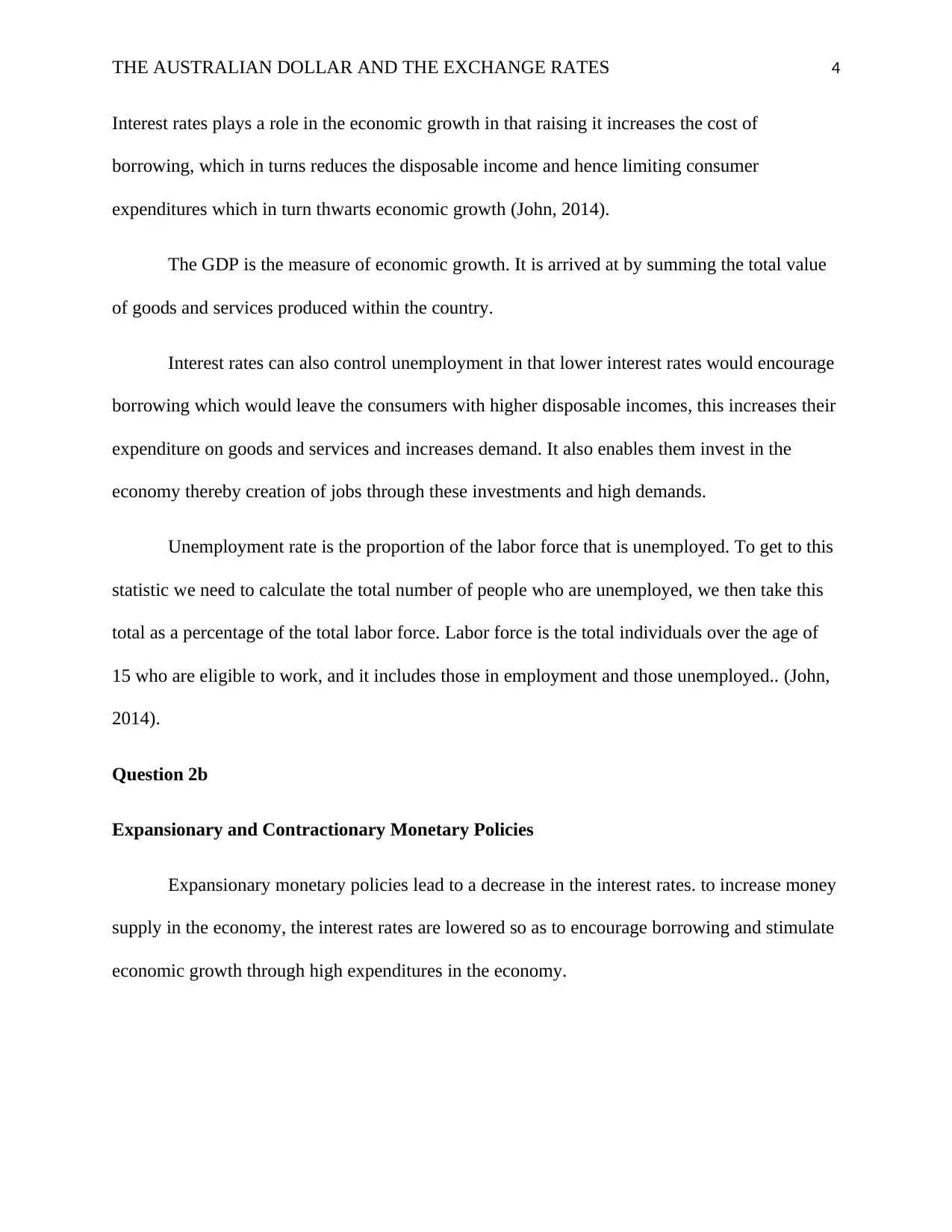
THE AUSTRALIAN DOLLAR AND THE EXCHANGE RATES 4
Interest rates plays a role in the economic growth in that raising it increases the cost of
borrowing, which in turns reduces the disposable income and hence limiting consumer
expenditures which in turn thwarts economic growth (John, 2014).
The GDP is the measure of economic growth. It is arrived at by summing the total value
of goods and services produced within the country.
Interest rates can also control unemployment in that lower interest rates would encourage
borrowing which would leave the consumers with higher disposable incomes, this increases their
expenditure on goods and services and increases demand. It also enables them invest in the
economy thereby creation of jobs through these investments and high demands.
Unemployment rate is the proportion of the labor force that is unemployed. To get to this
statistic we need to calculate the total number of people who are unemployed, we then take this
total as a percentage of the total labor force. Labor force is the total individuals over the age of
15 who are eligible to work, and it includes those in employment and those unemployed.. (John,
2014).
Question 2b
Expansionary and Contractionary Monetary Policies
Expansionary monetary policies lead to a decrease in the interest rates. to increase money
supply in the economy, the interest rates are lowered so as to encourage borrowing and stimulate
economic growth through high expenditures in the economy.
Interest rates plays a role in the economic growth in that raising it increases the cost of
borrowing, which in turns reduces the disposable income and hence limiting consumer
expenditures which in turn thwarts economic growth (John, 2014).
The GDP is the measure of economic growth. It is arrived at by summing the total value
of goods and services produced within the country.
Interest rates can also control unemployment in that lower interest rates would encourage
borrowing which would leave the consumers with higher disposable incomes, this increases their
expenditure on goods and services and increases demand. It also enables them invest in the
economy thereby creation of jobs through these investments and high demands.
Unemployment rate is the proportion of the labor force that is unemployed. To get to this
statistic we need to calculate the total number of people who are unemployed, we then take this
total as a percentage of the total labor force. Labor force is the total individuals over the age of
15 who are eligible to work, and it includes those in employment and those unemployed.. (John,
2014).
Question 2b
Expansionary and Contractionary Monetary Policies
Expansionary monetary policies lead to a decrease in the interest rates. to increase money
supply in the economy, the interest rates are lowered so as to encourage borrowing and stimulate
economic growth through high expenditures in the economy.
Secure Best Marks with AI Grader
Need help grading? Try our AI Grader for instant feedback on your assignments.
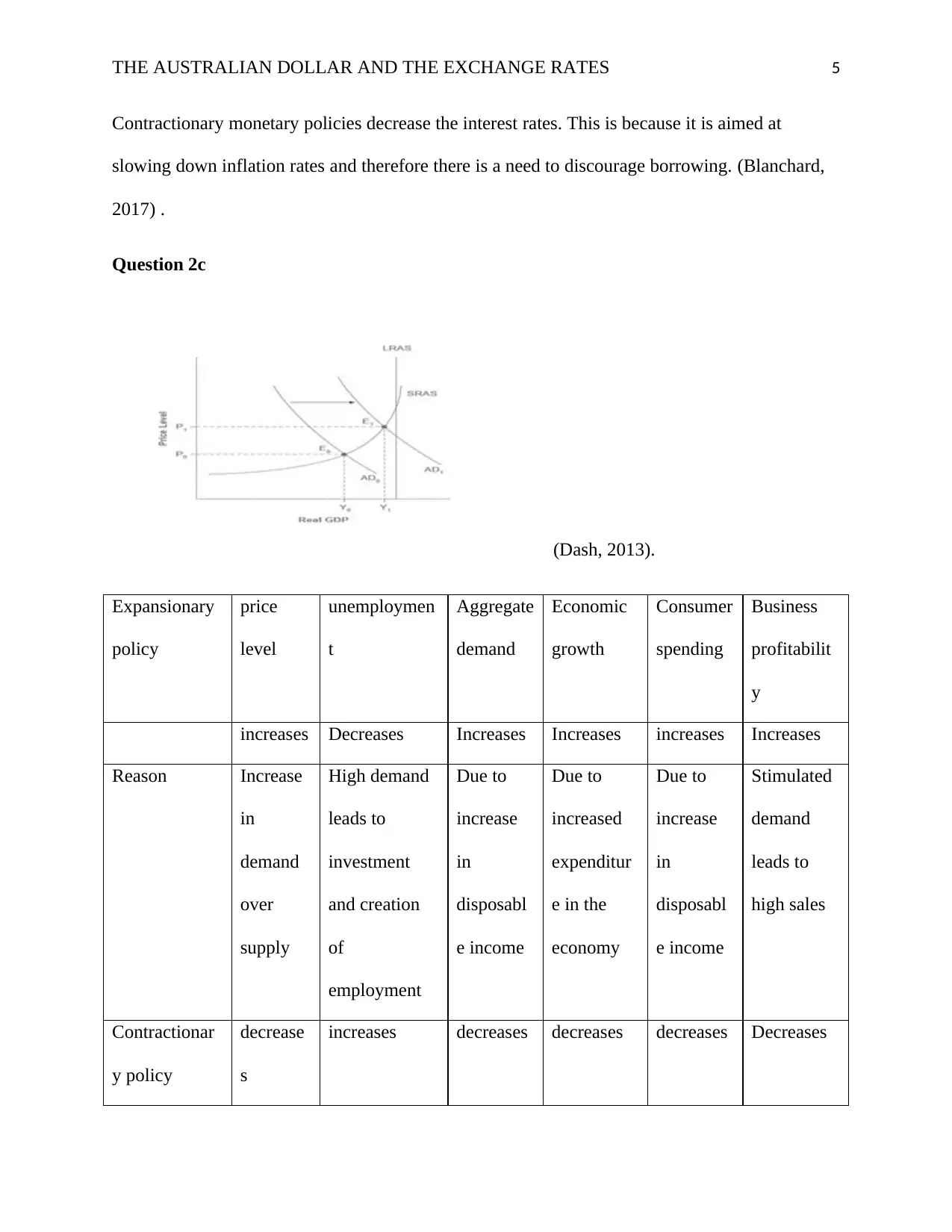
THE AUSTRALIAN DOLLAR AND THE EXCHANGE RATES 5
Contractionary monetary policies decrease the interest rates. This is because it is aimed at
slowing down inflation rates and therefore there is a need to discourage borrowing. (Blanchard,
2017) .
Question 2c
(Dash, 2013).
Expansionary
policy
price
level
unemploymen
t
Aggregate
demand
Economic
growth
Consumer
spending
Business
profitabilit
y
increases Decreases Increases Increases increases Increases
Reason Increase
in
demand
over
supply
High demand
leads to
investment
and creation
of
employment
Due to
increase
in
disposabl
e income
Due to
increased
expenditur
e in the
economy
Due to
increase
in
disposabl
e income
Stimulated
demand
leads to
high sales
Contractionar
y policy
decrease
s
increases decreases decreases decreases Decreases
Contractionary monetary policies decrease the interest rates. This is because it is aimed at
slowing down inflation rates and therefore there is a need to discourage borrowing. (Blanchard,
2017) .
Question 2c
(Dash, 2013).
Expansionary
policy
price
level
unemploymen
t
Aggregate
demand
Economic
growth
Consumer
spending
Business
profitabilit
y
increases Decreases Increases Increases increases Increases
Reason Increase
in
demand
over
supply
High demand
leads to
investment
and creation
of
employment
Due to
increase
in
disposabl
e income
Due to
increased
expenditur
e in the
economy
Due to
increase
in
disposabl
e income
Stimulated
demand
leads to
high sales
Contractionar
y policy
decrease
s
increases decreases decreases decreases Decreases
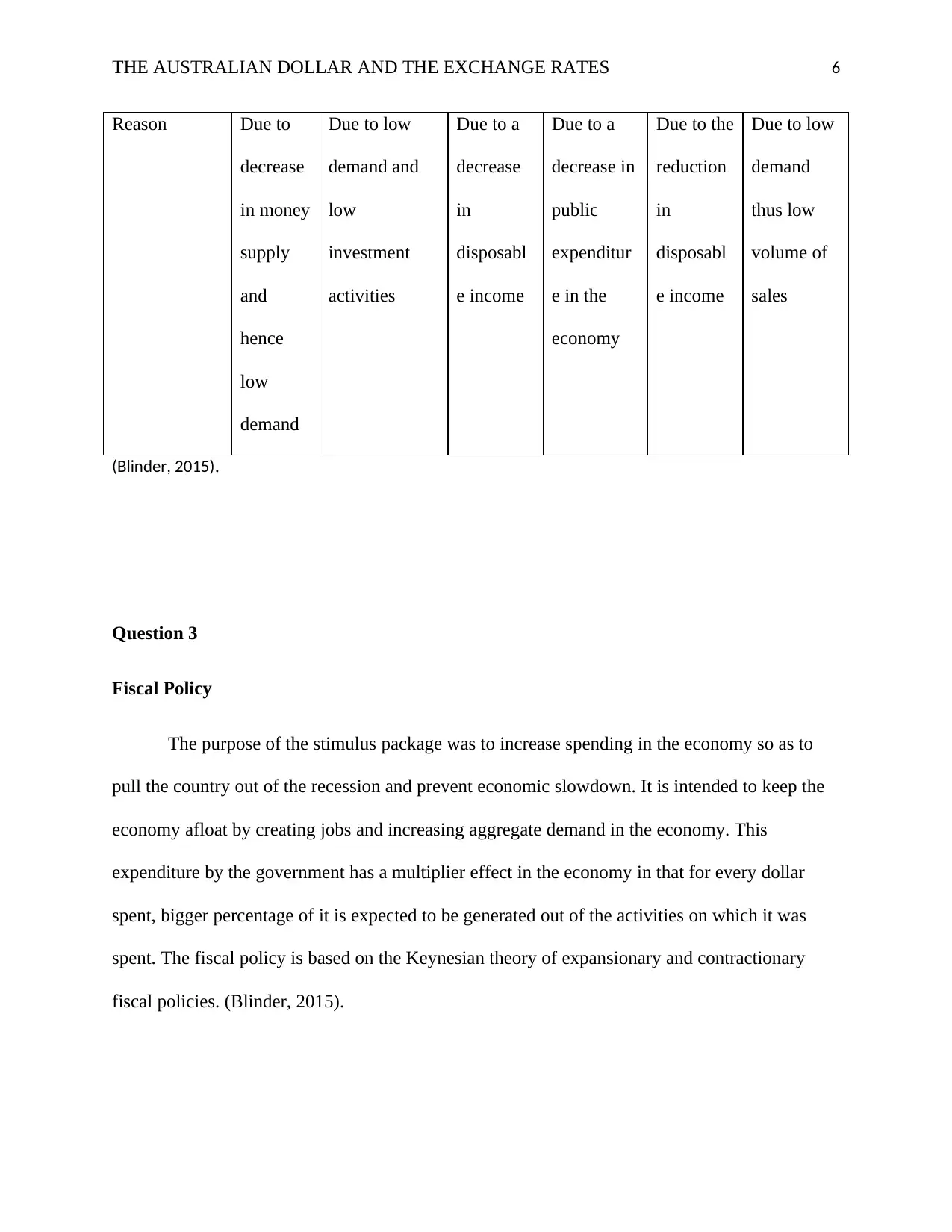
THE AUSTRALIAN DOLLAR AND THE EXCHANGE RATES 6
Reason Due to
decrease
in money
supply
and
hence
low
demand
Due to low
demand and
low
investment
activities
Due to a
decrease
in
disposabl
e income
Due to a
decrease in
public
expenditur
e in the
economy
Due to the
reduction
in
disposabl
e income
Due to low
demand
thus low
volume of
sales
(Blinder, 2015).
Question 3
Fiscal Policy
The purpose of the stimulus package was to increase spending in the economy so as to
pull the country out of the recession and prevent economic slowdown. It is intended to keep the
economy afloat by creating jobs and increasing aggregate demand in the economy. This
expenditure by the government has a multiplier effect in the economy in that for every dollar
spent, bigger percentage of it is expected to be generated out of the activities on which it was
spent. The fiscal policy is based on the Keynesian theory of expansionary and contractionary
fiscal policies. (Blinder, 2015).
Reason Due to
decrease
in money
supply
and
hence
low
demand
Due to low
demand and
low
investment
activities
Due to a
decrease
in
disposabl
e income
Due to a
decrease in
public
expenditur
e in the
economy
Due to the
reduction
in
disposabl
e income
Due to low
demand
thus low
volume of
sales
(Blinder, 2015).
Question 3
Fiscal Policy
The purpose of the stimulus package was to increase spending in the economy so as to
pull the country out of the recession and prevent economic slowdown. It is intended to keep the
economy afloat by creating jobs and increasing aggregate demand in the economy. This
expenditure by the government has a multiplier effect in the economy in that for every dollar
spent, bigger percentage of it is expected to be generated out of the activities on which it was
spent. The fiscal policy is based on the Keynesian theory of expansionary and contractionary
fiscal policies. (Blinder, 2015).
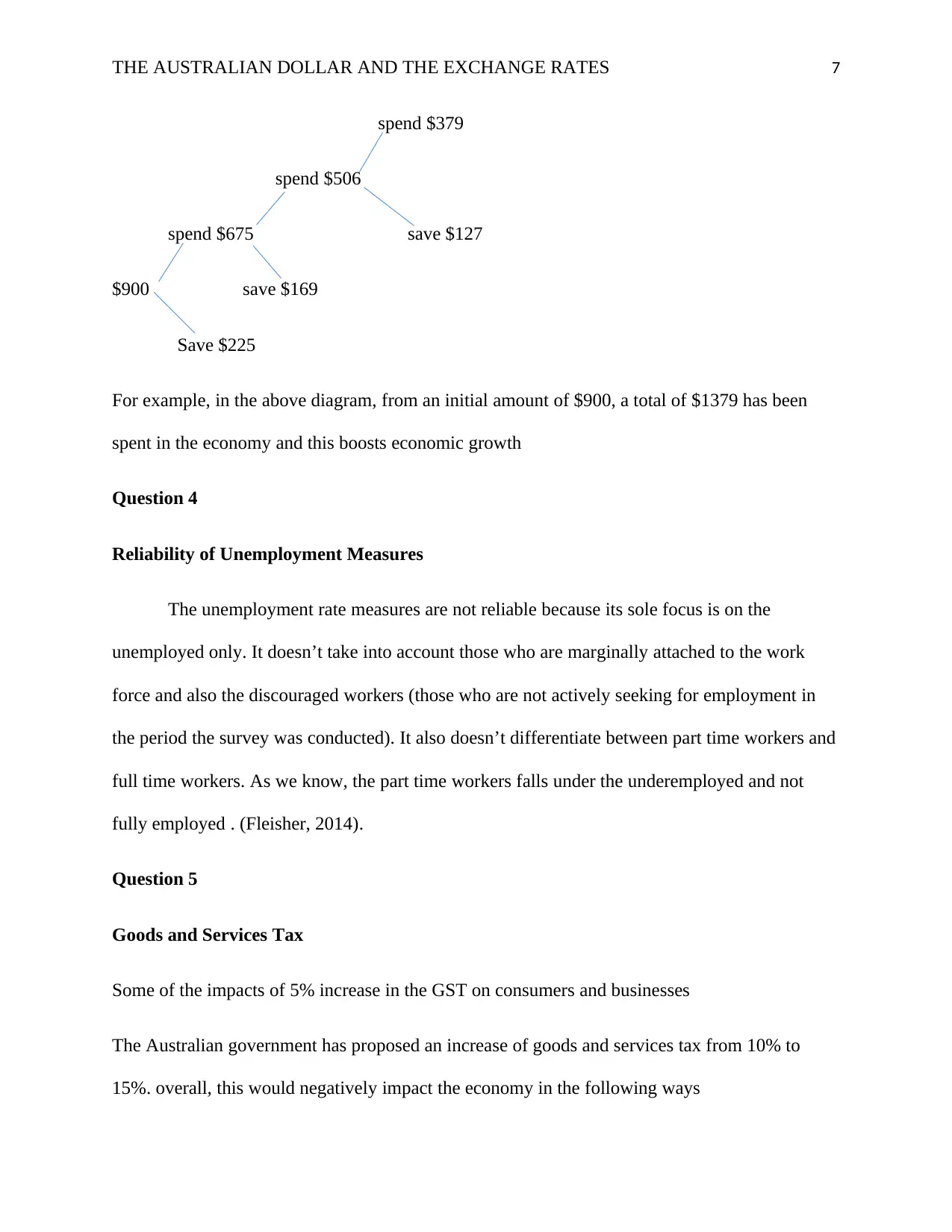
THE AUSTRALIAN DOLLAR AND THE EXCHANGE RATES 7
spend $379
spend $506
spend $675 save $127
$900 save $169
Save $225
For example, in the above diagram, from an initial amount of $900, a total of $1379 has been
spent in the economy and this boosts economic growth
Question 4
Reliability of Unemployment Measures
The unemployment rate measures are not reliable because its sole focus is on the
unemployed only. It doesn’t take into account those who are marginally attached to the work
force and also the discouraged workers (those who are not actively seeking for employment in
the period the survey was conducted). It also doesn’t differentiate between part time workers and
full time workers. As we know, the part time workers falls under the underemployed and not
fully employed . (Fleisher, 2014).
Question 5
Goods and Services Tax
Some of the impacts of 5% increase in the GST on consumers and businesses
The Australian government has proposed an increase of goods and services tax from 10% to
15%. overall, this would negatively impact the economy in the following ways
spend $379
spend $506
spend $675 save $127
$900 save $169
Save $225
For example, in the above diagram, from an initial amount of $900, a total of $1379 has been
spent in the economy and this boosts economic growth
Question 4
Reliability of Unemployment Measures
The unemployment rate measures are not reliable because its sole focus is on the
unemployed only. It doesn’t take into account those who are marginally attached to the work
force and also the discouraged workers (those who are not actively seeking for employment in
the period the survey was conducted). It also doesn’t differentiate between part time workers and
full time workers. As we know, the part time workers falls under the underemployed and not
fully employed . (Fleisher, 2014).
Question 5
Goods and Services Tax
Some of the impacts of 5% increase in the GST on consumers and businesses
The Australian government has proposed an increase of goods and services tax from 10% to
15%. overall, this would negatively impact the economy in the following ways
Paraphrase This Document
Need a fresh take? Get an instant paraphrase of this document with our AI Paraphraser
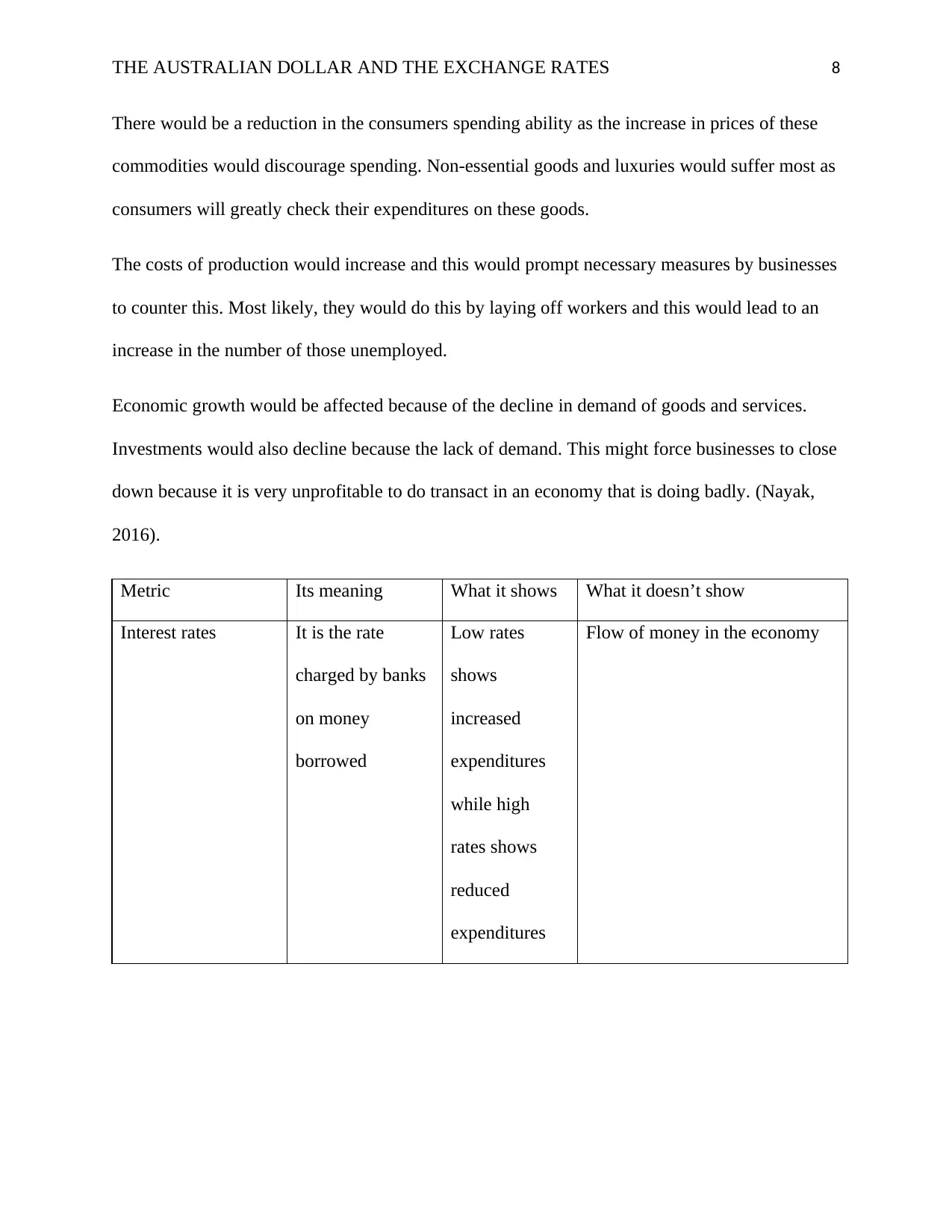
THE AUSTRALIAN DOLLAR AND THE EXCHANGE RATES 8
There would be a reduction in the consumers spending ability as the increase in prices of these
commodities would discourage spending. Non-essential goods and luxuries would suffer most as
consumers will greatly check their expenditures on these goods.
The costs of production would increase and this would prompt necessary measures by businesses
to counter this. Most likely, they would do this by laying off workers and this would lead to an
increase in the number of those unemployed.
Economic growth would be affected because of the decline in demand of goods and services.
Investments would also decline because the lack of demand. This might force businesses to close
down because it is very unprofitable to do transact in an economy that is doing badly. (Nayak,
2016).
Metric Its meaning What it shows What it doesn’t show
Interest rates It is the rate
charged by banks
on money
borrowed
Low rates
shows
increased
expenditures
while high
rates shows
reduced
expenditures
Flow of money in the economy
There would be a reduction in the consumers spending ability as the increase in prices of these
commodities would discourage spending. Non-essential goods and luxuries would suffer most as
consumers will greatly check their expenditures on these goods.
The costs of production would increase and this would prompt necessary measures by businesses
to counter this. Most likely, they would do this by laying off workers and this would lead to an
increase in the number of those unemployed.
Economic growth would be affected because of the decline in demand of goods and services.
Investments would also decline because the lack of demand. This might force businesses to close
down because it is very unprofitable to do transact in an economy that is doing badly. (Nayak,
2016).
Metric Its meaning What it shows What it doesn’t show
Interest rates It is the rate
charged by banks
on money
borrowed
Low rates
shows
increased
expenditures
while high
rates shows
reduced
expenditures
Flow of money in the economy
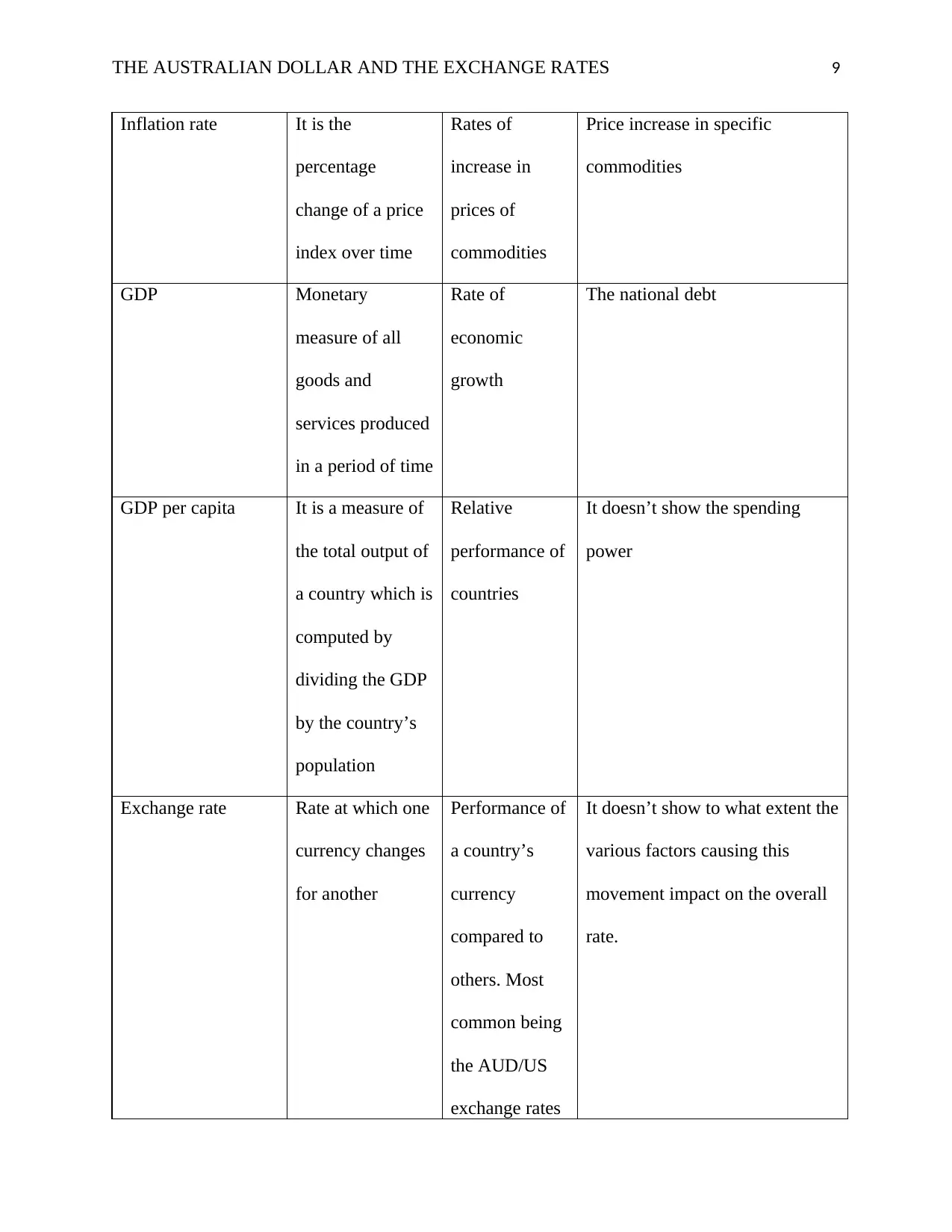
THE AUSTRALIAN DOLLAR AND THE EXCHANGE RATES 9
Inflation rate It is the
percentage
change of a price
index over time
Rates of
increase in
prices of
commodities
Price increase in specific
commodities
GDP Monetary
measure of all
goods and
services produced
in a period of time
Rate of
economic
growth
The national debt
GDP per capita It is a measure of
the total output of
a country which is
computed by
dividing the GDP
by the country’s
population
Relative
performance of
countries
It doesn’t show the spending
power
Exchange rate Rate at which one
currency changes
for another
Performance of
a country’s
currency
compared to
others. Most
common being
the AUD/US
exchange rates
It doesn’t show to what extent the
various factors causing this
movement impact on the overall
rate.
Inflation rate It is the
percentage
change of a price
index over time
Rates of
increase in
prices of
commodities
Price increase in specific
commodities
GDP Monetary
measure of all
goods and
services produced
in a period of time
Rate of
economic
growth
The national debt
GDP per capita It is a measure of
the total output of
a country which is
computed by
dividing the GDP
by the country’s
population
Relative
performance of
countries
It doesn’t show the spending
power
Exchange rate Rate at which one
currency changes
for another
Performance of
a country’s
currency
compared to
others. Most
common being
the AUD/US
exchange rates
It doesn’t show to what extent the
various factors causing this
movement impact on the overall
rate.
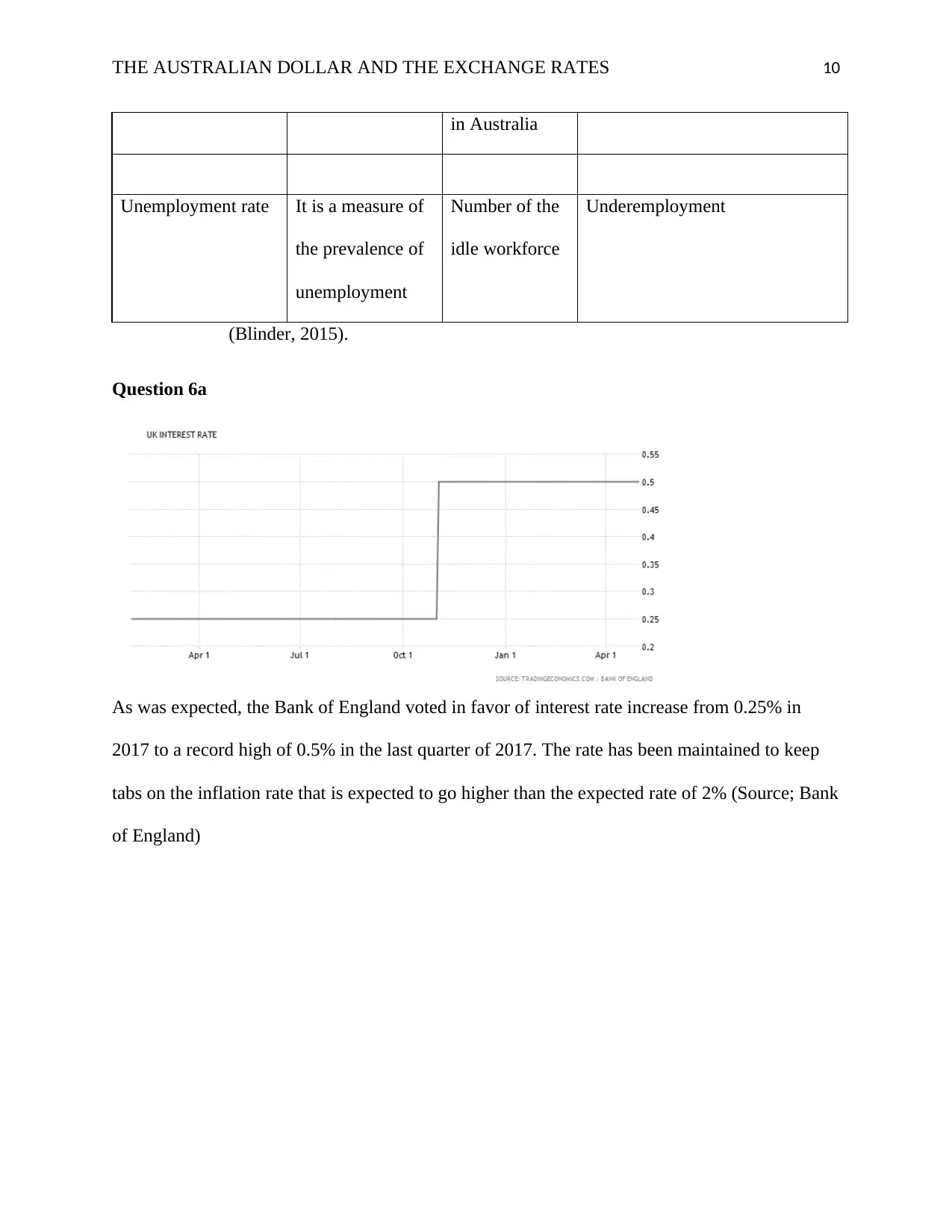
THE AUSTRALIAN DOLLAR AND THE EXCHANGE RATES 10
in Australia
Unemployment rate It is a measure of
the prevalence of
unemployment
Number of the
idle workforce
Underemployment
(Blinder, 2015).
Question 6a
As was expected, the Bank of England voted in favor of interest rate increase from 0.25% in
2017 to a record high of 0.5% in the last quarter of 2017. The rate has been maintained to keep
tabs on the inflation rate that is expected to go higher than the expected rate of 2% (Source; Bank
of England)
in Australia
Unemployment rate It is a measure of
the prevalence of
unemployment
Number of the
idle workforce
Underemployment
(Blinder, 2015).
Question 6a
As was expected, the Bank of England voted in favor of interest rate increase from 0.25% in
2017 to a record high of 0.5% in the last quarter of 2017. The rate has been maintained to keep
tabs on the inflation rate that is expected to go higher than the expected rate of 2% (Source; Bank
of England)
Secure Best Marks with AI Grader
Need help grading? Try our AI Grader for instant feedback on your assignments.
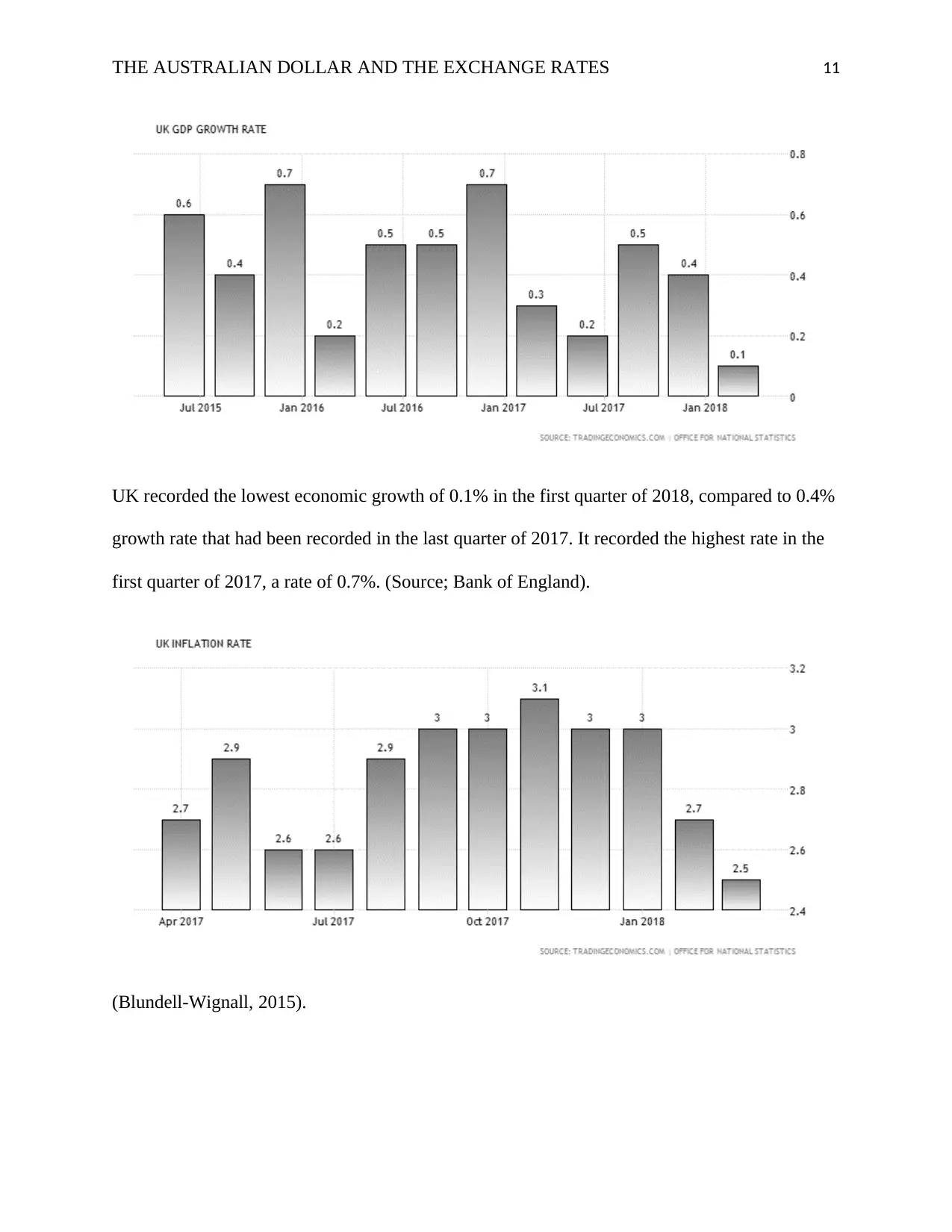
THE AUSTRALIAN DOLLAR AND THE EXCHANGE RATES 11
UK recorded the lowest economic growth of 0.1% in the first quarter of 2018, compared to 0.4%
growth rate that had been recorded in the last quarter of 2017. It recorded the highest rate in the
first quarter of 2017, a rate of 0.7%. (Source; Bank of England).
(Blundell-Wignall, 2015).
UK recorded the lowest economic growth of 0.1% in the first quarter of 2018, compared to 0.4%
growth rate that had been recorded in the last quarter of 2017. It recorded the highest rate in the
first quarter of 2017, a rate of 0.7%. (Source; Bank of England).
(Blundell-Wignall, 2015).
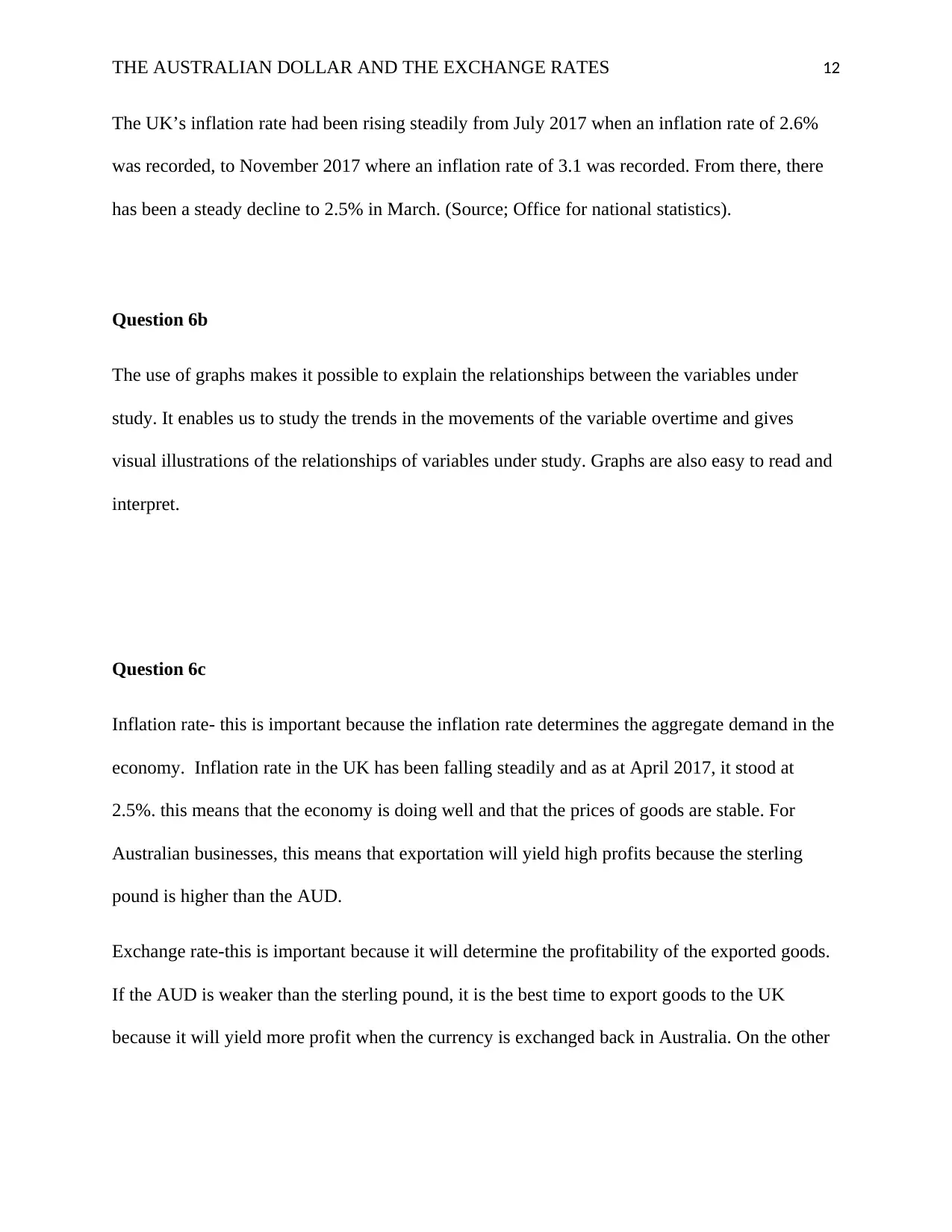
THE AUSTRALIAN DOLLAR AND THE EXCHANGE RATES 12
The UK’s inflation rate had been rising steadily from July 2017 when an inflation rate of 2.6%
was recorded, to November 2017 where an inflation rate of 3.1 was recorded. From there, there
has been a steady decline to 2.5% in March. (Source; Office for national statistics).
Question 6b
The use of graphs makes it possible to explain the relationships between the variables under
study. It enables us to study the trends in the movements of the variable overtime and gives
visual illustrations of the relationships of variables under study. Graphs are also easy to read and
interpret.
Question 6c
Inflation rate- this is important because the inflation rate determines the aggregate demand in the
economy. Inflation rate in the UK has been falling steadily and as at April 2017, it stood at
2.5%. this means that the economy is doing well and that the prices of goods are stable. For
Australian businesses, this means that exportation will yield high profits because the sterling
pound is higher than the AUD.
Exchange rate-this is important because it will determine the profitability of the exported goods.
If the AUD is weaker than the sterling pound, it is the best time to export goods to the UK
because it will yield more profit when the currency is exchanged back in Australia. On the other
The UK’s inflation rate had been rising steadily from July 2017 when an inflation rate of 2.6%
was recorded, to November 2017 where an inflation rate of 3.1 was recorded. From there, there
has been a steady decline to 2.5% in March. (Source; Office for national statistics).
Question 6b
The use of graphs makes it possible to explain the relationships between the variables under
study. It enables us to study the trends in the movements of the variable overtime and gives
visual illustrations of the relationships of variables under study. Graphs are also easy to read and
interpret.
Question 6c
Inflation rate- this is important because the inflation rate determines the aggregate demand in the
economy. Inflation rate in the UK has been falling steadily and as at April 2017, it stood at
2.5%. this means that the economy is doing well and that the prices of goods are stable. For
Australian businesses, this means that exportation will yield high profits because the sterling
pound is higher than the AUD.
Exchange rate-this is important because it will determine the profitability of the exported goods.
If the AUD is weaker than the sterling pound, it is the best time to export goods to the UK
because it will yield more profit when the currency is exchanged back in Australia. On the other
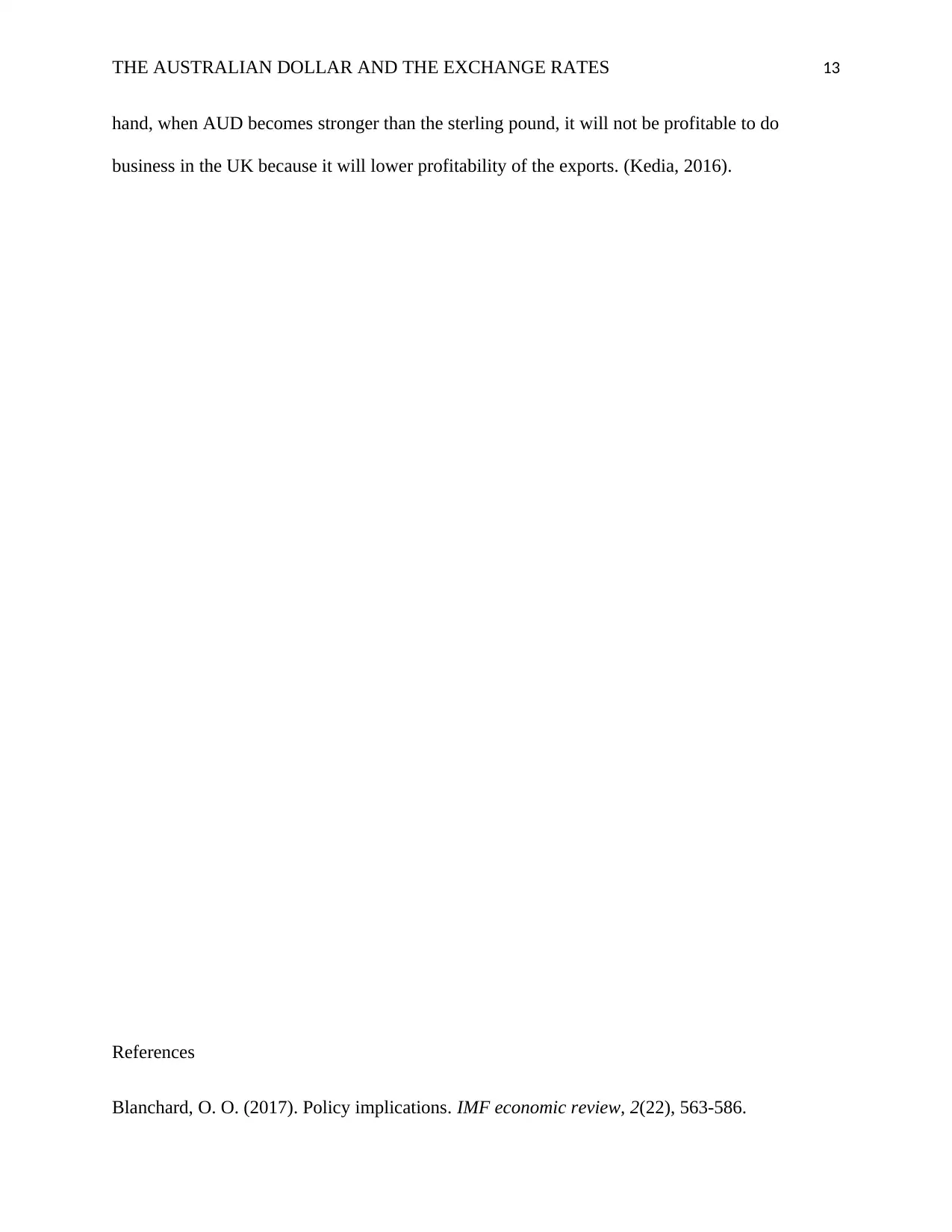
THE AUSTRALIAN DOLLAR AND THE EXCHANGE RATES 13
hand, when AUD becomes stronger than the sterling pound, it will not be profitable to do
business in the UK because it will lower profitability of the exports. (Kedia, 2016).
References
Blanchard, O. O. (2017). Policy implications. IMF economic review, 2(22), 563-586.
hand, when AUD becomes stronger than the sterling pound, it will not be profitable to do
business in the UK because it will lower profitability of the exports. (Kedia, 2016).
References
Blanchard, O. O. (2017). Policy implications. IMF economic review, 2(22), 563-586.
Paraphrase This Document
Need a fresh take? Get an instant paraphrase of this document with our AI Paraphraser
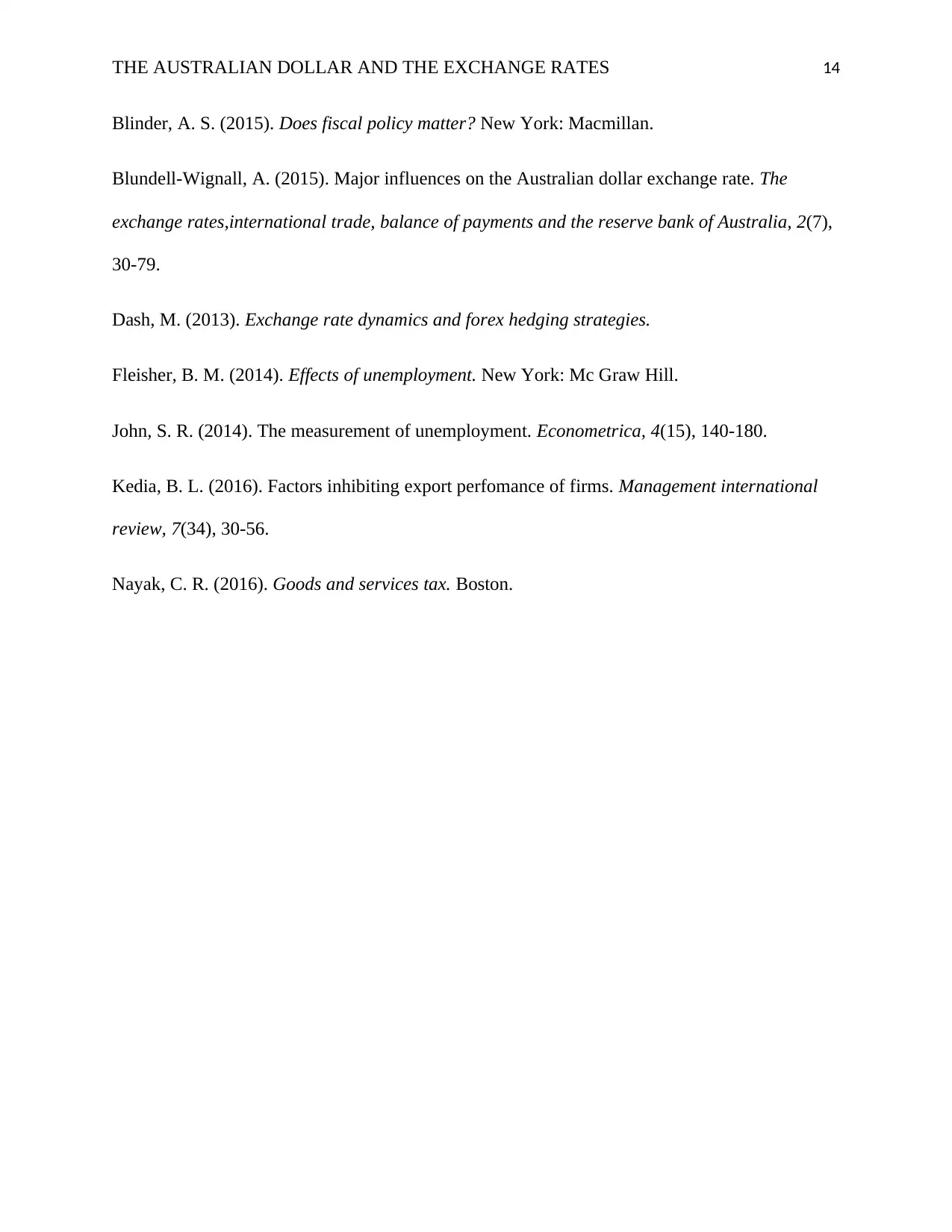
THE AUSTRALIAN DOLLAR AND THE EXCHANGE RATES 14
Blinder, A. S. (2015). Does fiscal policy matter? New York: Macmillan.
Blundell-Wignall, A. (2015). Major influences on the Australian dollar exchange rate. The
exchange rates,international trade, balance of payments and the reserve bank of Australia, 2(7),
30-79.
Dash, M. (2013). Exchange rate dynamics and forex hedging strategies.
Fleisher, B. M. (2014). Effects of unemployment. New York: Mc Graw Hill.
John, S. R. (2014). The measurement of unemployment. Econometrica, 4(15), 140-180.
Kedia, B. L. (2016). Factors inhibiting export perfomance of firms. Management international
review, 7(34), 30-56.
Nayak, C. R. (2016). Goods and services tax. Boston.
Blinder, A. S. (2015). Does fiscal policy matter? New York: Macmillan.
Blundell-Wignall, A. (2015). Major influences on the Australian dollar exchange rate. The
exchange rates,international trade, balance of payments and the reserve bank of Australia, 2(7),
30-79.
Dash, M. (2013). Exchange rate dynamics and forex hedging strategies.
Fleisher, B. M. (2014). Effects of unemployment. New York: Mc Graw Hill.
John, S. R. (2014). The measurement of unemployment. Econometrica, 4(15), 140-180.
Kedia, B. L. (2016). Factors inhibiting export perfomance of firms. Management international
review, 7(34), 30-56.
Nayak, C. R. (2016). Goods and services tax. Boston.
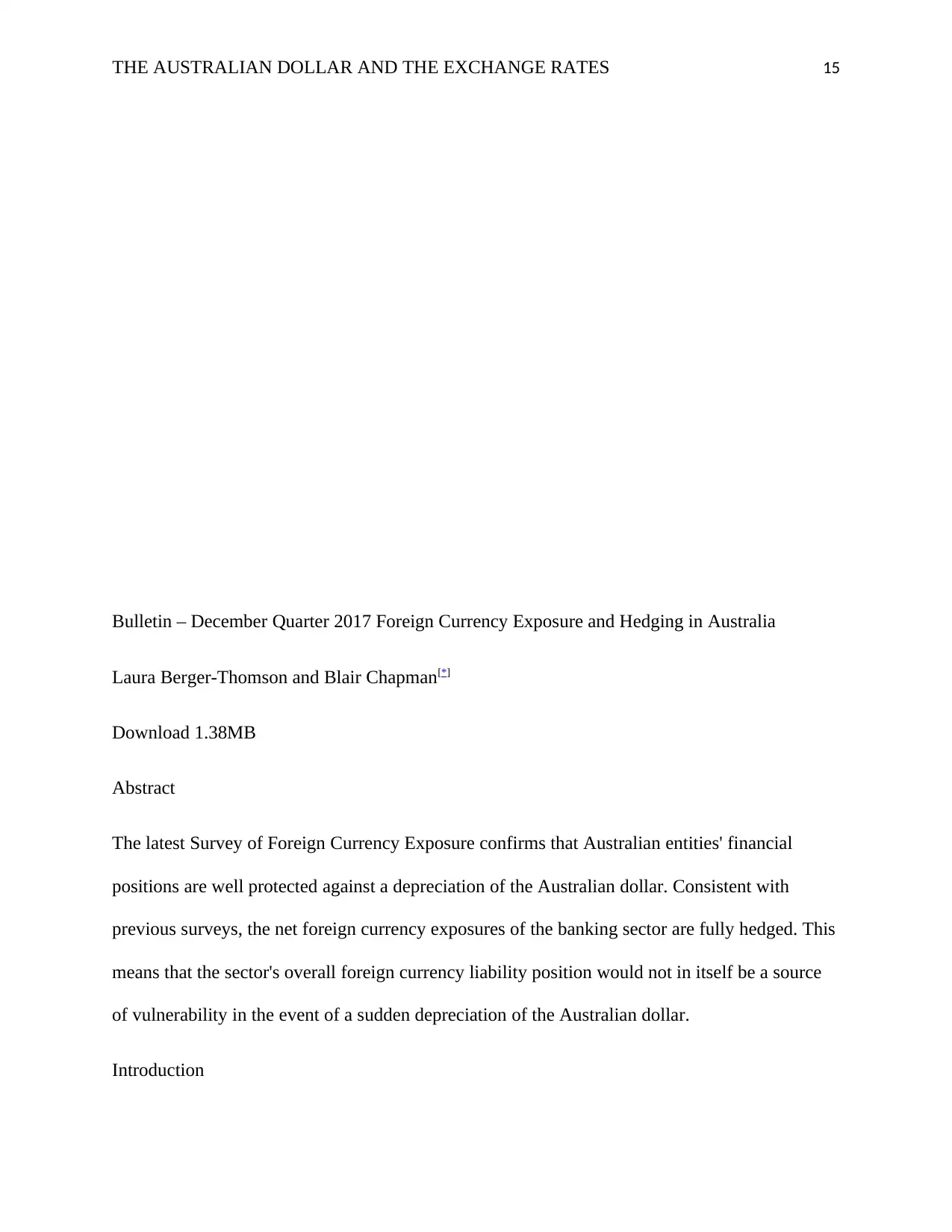
THE AUSTRALIAN DOLLAR AND THE EXCHANGE RATES 15
Bulletin – December Quarter 2017 Foreign Currency Exposure and Hedging in Australia
Laura Berger-Thomson and Blair Chapman[*]
Download 1.38MB
Abstract
The latest Survey of Foreign Currency Exposure confirms that Australian entities' financial
positions are well protected against a depreciation of the Australian dollar. Consistent with
previous surveys, the net foreign currency exposures of the banking sector are fully hedged. This
means that the sector's overall foreign currency liability position would not in itself be a source
of vulnerability in the event of a sudden depreciation of the Australian dollar.
Introduction
Bulletin – December Quarter 2017 Foreign Currency Exposure and Hedging in Australia
Laura Berger-Thomson and Blair Chapman[*]
Download 1.38MB
Abstract
The latest Survey of Foreign Currency Exposure confirms that Australian entities' financial
positions are well protected against a depreciation of the Australian dollar. Consistent with
previous surveys, the net foreign currency exposures of the banking sector are fully hedged. This
means that the sector's overall foreign currency liability position would not in itself be a source
of vulnerability in the event of a sudden depreciation of the Australian dollar.
Introduction
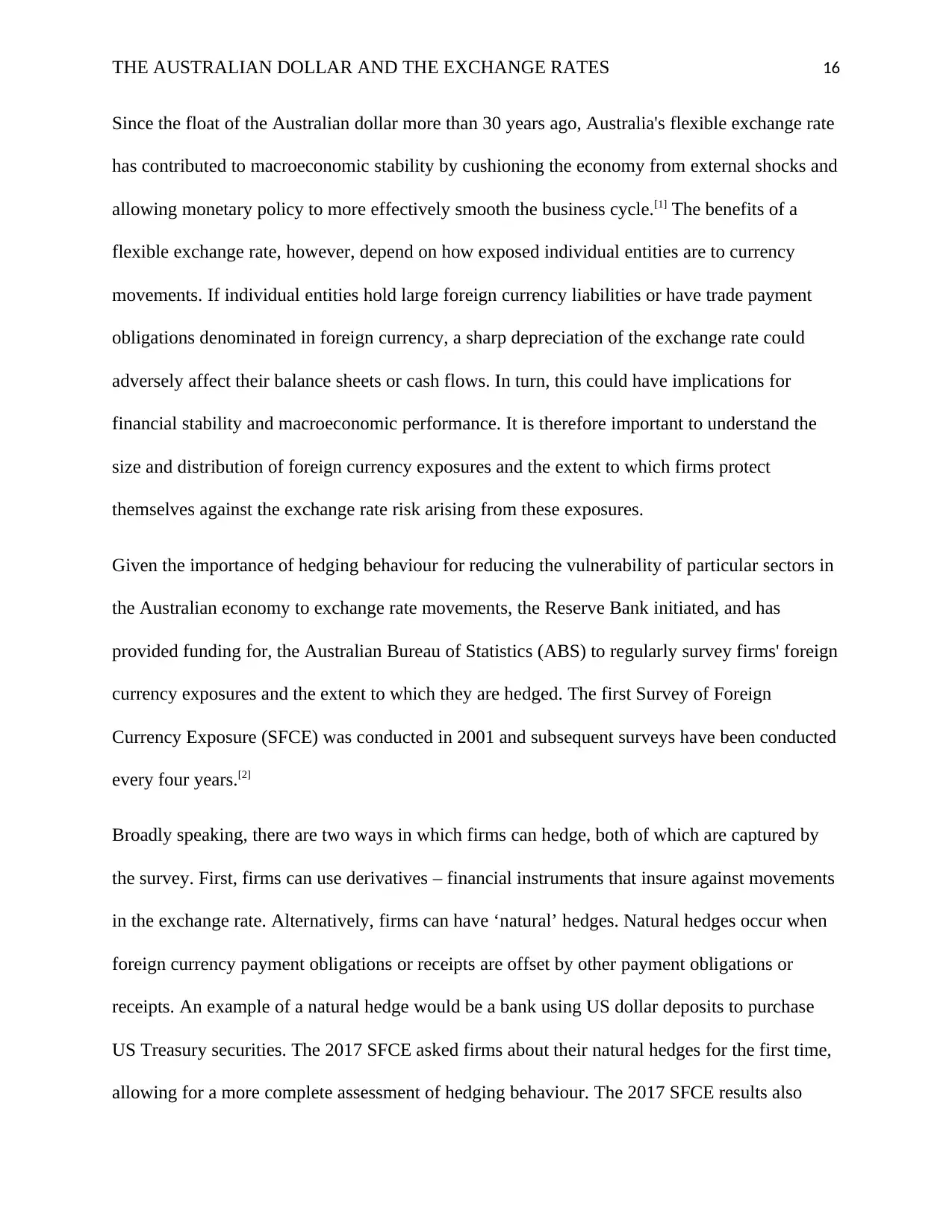
THE AUSTRALIAN DOLLAR AND THE EXCHANGE RATES 16
Since the float of the Australian dollar more than 30 years ago, Australia's flexible exchange rate
has contributed to macroeconomic stability by cushioning the economy from external shocks and
allowing monetary policy to more effectively smooth the business cycle.[1] The benefits of a
flexible exchange rate, however, depend on how exposed individual entities are to currency
movements. If individual entities hold large foreign currency liabilities or have trade payment
obligations denominated in foreign currency, a sharp depreciation of the exchange rate could
adversely affect their balance sheets or cash flows. In turn, this could have implications for
financial stability and macroeconomic performance. It is therefore important to understand the
size and distribution of foreign currency exposures and the extent to which firms protect
themselves against the exchange rate risk arising from these exposures.
Given the importance of hedging behaviour for reducing the vulnerability of particular sectors in
the Australian economy to exchange rate movements, the Reserve Bank initiated, and has
provided funding for, the Australian Bureau of Statistics (ABS) to regularly survey firms' foreign
currency exposures and the extent to which they are hedged. The first Survey of Foreign
Currency Exposure (SFCE) was conducted in 2001 and subsequent surveys have been conducted
every four years.[2]
Broadly speaking, there are two ways in which firms can hedge, both of which are captured by
the survey. First, firms can use derivatives – financial instruments that insure against movements
in the exchange rate. Alternatively, firms can have ‘natural’ hedges. Natural hedges occur when
foreign currency payment obligations or receipts are offset by other payment obligations or
receipts. An example of a natural hedge would be a bank using US dollar deposits to purchase
US Treasury securities. The 2017 SFCE asked firms about their natural hedges for the first time,
allowing for a more complete assessment of hedging behaviour. The 2017 SFCE results also
Since the float of the Australian dollar more than 30 years ago, Australia's flexible exchange rate
has contributed to macroeconomic stability by cushioning the economy from external shocks and
allowing monetary policy to more effectively smooth the business cycle.[1] The benefits of a
flexible exchange rate, however, depend on how exposed individual entities are to currency
movements. If individual entities hold large foreign currency liabilities or have trade payment
obligations denominated in foreign currency, a sharp depreciation of the exchange rate could
adversely affect their balance sheets or cash flows. In turn, this could have implications for
financial stability and macroeconomic performance. It is therefore important to understand the
size and distribution of foreign currency exposures and the extent to which firms protect
themselves against the exchange rate risk arising from these exposures.
Given the importance of hedging behaviour for reducing the vulnerability of particular sectors in
the Australian economy to exchange rate movements, the Reserve Bank initiated, and has
provided funding for, the Australian Bureau of Statistics (ABS) to regularly survey firms' foreign
currency exposures and the extent to which they are hedged. The first Survey of Foreign
Currency Exposure (SFCE) was conducted in 2001 and subsequent surveys have been conducted
every four years.[2]
Broadly speaking, there are two ways in which firms can hedge, both of which are captured by
the survey. First, firms can use derivatives – financial instruments that insure against movements
in the exchange rate. Alternatively, firms can have ‘natural’ hedges. Natural hedges occur when
foreign currency payment obligations or receipts are offset by other payment obligations or
receipts. An example of a natural hedge would be a bank using US dollar deposits to purchase
US Treasury securities. The 2017 SFCE asked firms about their natural hedges for the first time,
allowing for a more complete assessment of hedging behaviour. The 2017 SFCE results also
Secure Best Marks with AI Grader
Need help grading? Try our AI Grader for instant feedback on your assignments.
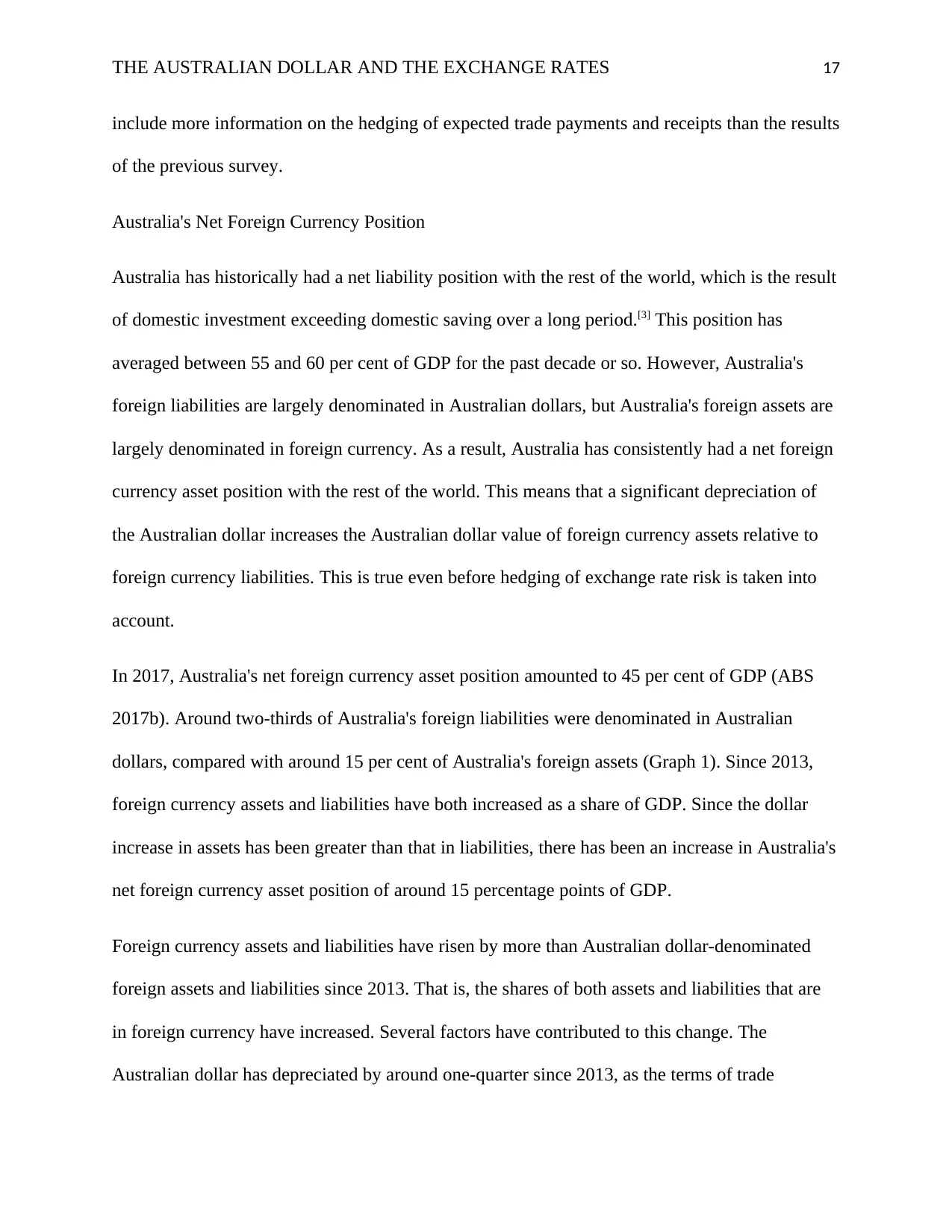
THE AUSTRALIAN DOLLAR AND THE EXCHANGE RATES 17
include more information on the hedging of expected trade payments and receipts than the results
of the previous survey.
Australia's Net Foreign Currency Position
Australia has historically had a net liability position with the rest of the world, which is the result
of domestic investment exceeding domestic saving over a long period.[3] This position has
averaged between 55 and 60 per cent of GDP for the past decade or so. However, Australia's
foreign liabilities are largely denominated in Australian dollars, but Australia's foreign assets are
largely denominated in foreign currency. As a result, Australia has consistently had a net foreign
currency asset position with the rest of the world. This means that a significant depreciation of
the Australian dollar increases the Australian dollar value of foreign currency assets relative to
foreign currency liabilities. This is true even before hedging of exchange rate risk is taken into
account.
In 2017, Australia's net foreign currency asset position amounted to 45 per cent of GDP (ABS
2017b). Around two-thirds of Australia's foreign liabilities were denominated in Australian
dollars, compared with around 15 per cent of Australia's foreign assets (Graph 1). Since 2013,
foreign currency assets and liabilities have both increased as a share of GDP. Since the dollar
increase in assets has been greater than that in liabilities, there has been an increase in Australia's
net foreign currency asset position of around 15 percentage points of GDP.
Foreign currency assets and liabilities have risen by more than Australian dollar-denominated
foreign assets and liabilities since 2013. That is, the shares of both assets and liabilities that are
in foreign currency have increased. Several factors have contributed to this change. The
Australian dollar has depreciated by around one-quarter since 2013, as the terms of trade
include more information on the hedging of expected trade payments and receipts than the results
of the previous survey.
Australia's Net Foreign Currency Position
Australia has historically had a net liability position with the rest of the world, which is the result
of domestic investment exceeding domestic saving over a long period.[3] This position has
averaged between 55 and 60 per cent of GDP for the past decade or so. However, Australia's
foreign liabilities are largely denominated in Australian dollars, but Australia's foreign assets are
largely denominated in foreign currency. As a result, Australia has consistently had a net foreign
currency asset position with the rest of the world. This means that a significant depreciation of
the Australian dollar increases the Australian dollar value of foreign currency assets relative to
foreign currency liabilities. This is true even before hedging of exchange rate risk is taken into
account.
In 2017, Australia's net foreign currency asset position amounted to 45 per cent of GDP (ABS
2017b). Around two-thirds of Australia's foreign liabilities were denominated in Australian
dollars, compared with around 15 per cent of Australia's foreign assets (Graph 1). Since 2013,
foreign currency assets and liabilities have both increased as a share of GDP. Since the dollar
increase in assets has been greater than that in liabilities, there has been an increase in Australia's
net foreign currency asset position of around 15 percentage points of GDP.
Foreign currency assets and liabilities have risen by more than Australian dollar-denominated
foreign assets and liabilities since 2013. That is, the shares of both assets and liabilities that are
in foreign currency have increased. Several factors have contributed to this change. The
Australian dollar has depreciated by around one-quarter since 2013, as the terms of trade
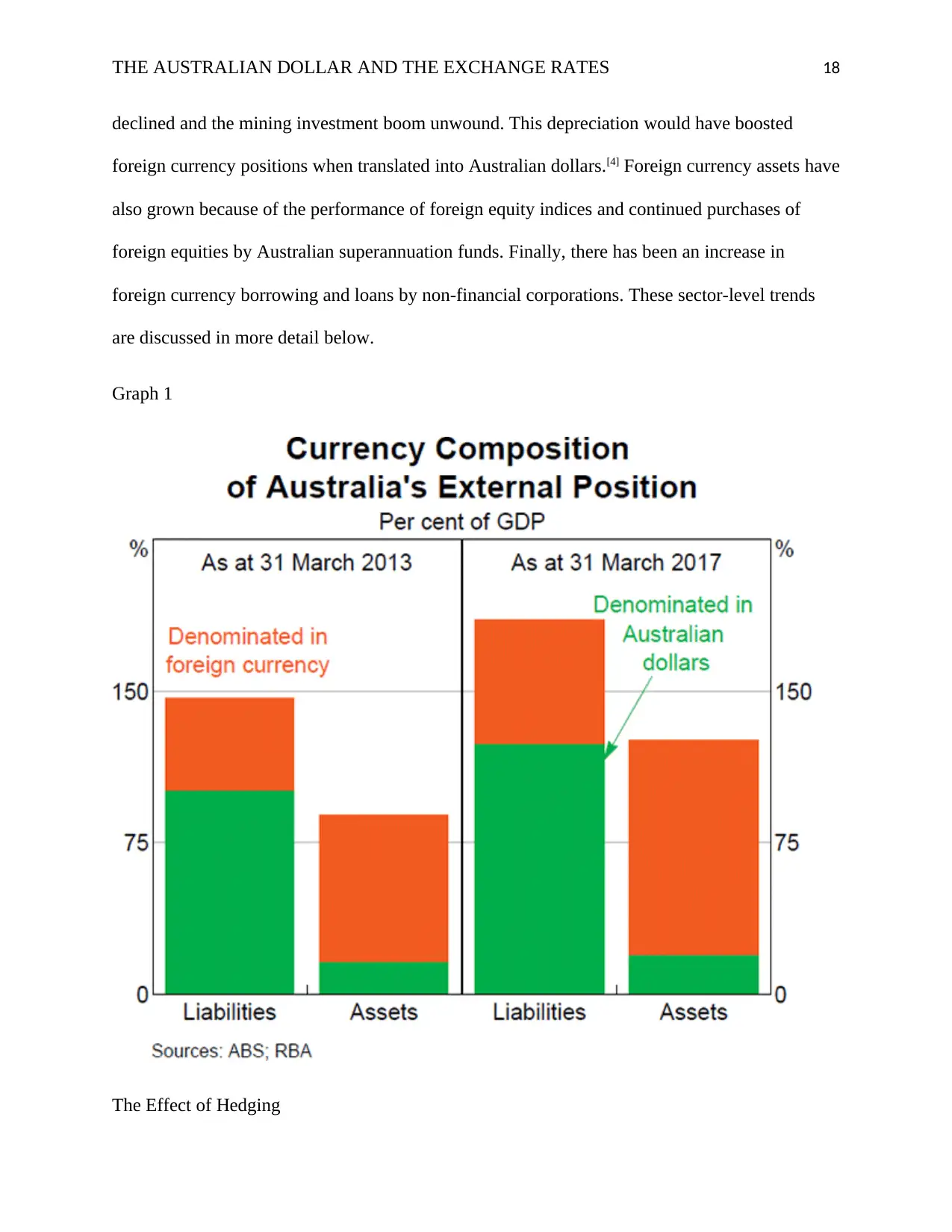
THE AUSTRALIAN DOLLAR AND THE EXCHANGE RATES 18
declined and the mining investment boom unwound. This depreciation would have boosted
foreign currency positions when translated into Australian dollars.[4] Foreign currency assets have
also grown because of the performance of foreign equity indices and continued purchases of
foreign equities by Australian superannuation funds. Finally, there has been an increase in
foreign currency borrowing and loans by non-financial corporations. These sector-level trends
are discussed in more detail below.
Graph 1
The Effect of Hedging
declined and the mining investment boom unwound. This depreciation would have boosted
foreign currency positions when translated into Australian dollars.[4] Foreign currency assets have
also grown because of the performance of foreign equity indices and continued purchases of
foreign equities by Australian superannuation funds. Finally, there has been an increase in
foreign currency borrowing and loans by non-financial corporations. These sector-level trends
are discussed in more detail below.
Graph 1
The Effect of Hedging

THE AUSTRALIAN DOLLAR AND THE EXCHANGE RATES 19
Hedging continues to increase Australia's net foreign currency position, as has been the case for
some time. After accounting for hedging with derivatives, Australia's effective net foreign
currency asset position was equivalent to around 50 per cent of GDP as at the end of March 2017
(Graph 2). This larger figure reflects the fact that more than half of foreign currency liabilities
are hedged back into Australian dollars, compared with around one-quarter of foreign currency
assets.
Graph 2
A smaller proportion of both assets and liabilities were hedged in March 2017 than in March
2013. In large part, this reflected significant growth over that period in the foreign currency
Hedging continues to increase Australia's net foreign currency position, as has been the case for
some time. After accounting for hedging with derivatives, Australia's effective net foreign
currency asset position was equivalent to around 50 per cent of GDP as at the end of March 2017
(Graph 2). This larger figure reflects the fact that more than half of foreign currency liabilities
are hedged back into Australian dollars, compared with around one-quarter of foreign currency
assets.
Graph 2
A smaller proportion of both assets and liabilities were hedged in March 2017 than in March
2013. In large part, this reflected significant growth over that period in the foreign currency
Paraphrase This Document
Need a fresh take? Get an instant paraphrase of this document with our AI Paraphraser
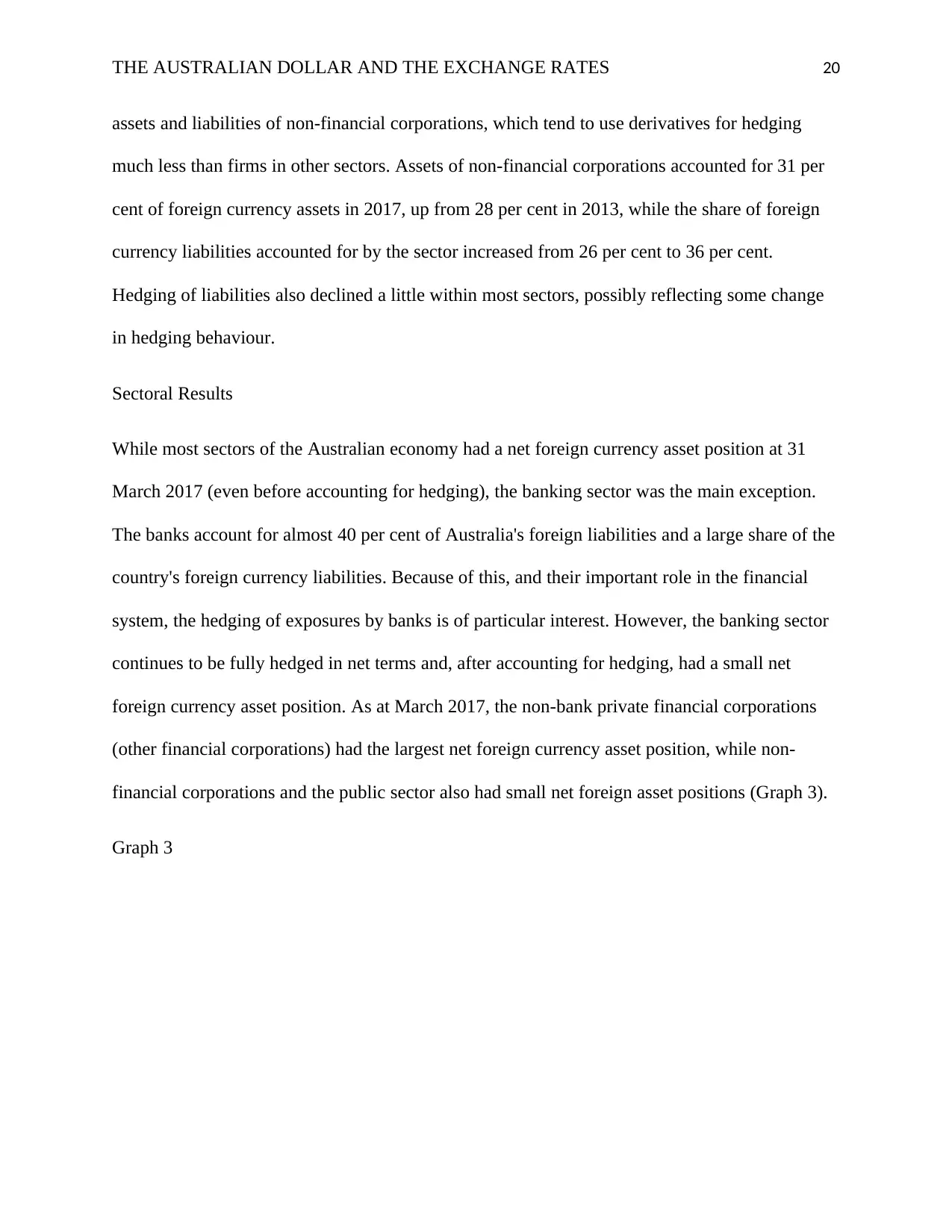
THE AUSTRALIAN DOLLAR AND THE EXCHANGE RATES 20
assets and liabilities of non-financial corporations, which tend to use derivatives for hedging
much less than firms in other sectors. Assets of non-financial corporations accounted for 31 per
cent of foreign currency assets in 2017, up from 28 per cent in 2013, while the share of foreign
currency liabilities accounted for by the sector increased from 26 per cent to 36 per cent.
Hedging of liabilities also declined a little within most sectors, possibly reflecting some change
in hedging behaviour.
Sectoral Results
While most sectors of the Australian economy had a net foreign currency asset position at 31
March 2017 (even before accounting for hedging), the banking sector was the main exception.
The banks account for almost 40 per cent of Australia's foreign liabilities and a large share of the
country's foreign currency liabilities. Because of this, and their important role in the financial
system, the hedging of exposures by banks is of particular interest. However, the banking sector
continues to be fully hedged in net terms and, after accounting for hedging, had a small net
foreign currency asset position. As at March 2017, the non-bank private financial corporations
(other financial corporations) had the largest net foreign currency asset position, while non-
financial corporations and the public sector also had small net foreign asset positions (Graph 3).
Graph 3
assets and liabilities of non-financial corporations, which tend to use derivatives for hedging
much less than firms in other sectors. Assets of non-financial corporations accounted for 31 per
cent of foreign currency assets in 2017, up from 28 per cent in 2013, while the share of foreign
currency liabilities accounted for by the sector increased from 26 per cent to 36 per cent.
Hedging of liabilities also declined a little within most sectors, possibly reflecting some change
in hedging behaviour.
Sectoral Results
While most sectors of the Australian economy had a net foreign currency asset position at 31
March 2017 (even before accounting for hedging), the banking sector was the main exception.
The banks account for almost 40 per cent of Australia's foreign liabilities and a large share of the
country's foreign currency liabilities. Because of this, and their important role in the financial
system, the hedging of exposures by banks is of particular interest. However, the banking sector
continues to be fully hedged in net terms and, after accounting for hedging, had a small net
foreign currency asset position. As at March 2017, the non-bank private financial corporations
(other financial corporations) had the largest net foreign currency asset position, while non-
financial corporations and the public sector also had small net foreign asset positions (Graph 3).
Graph 3
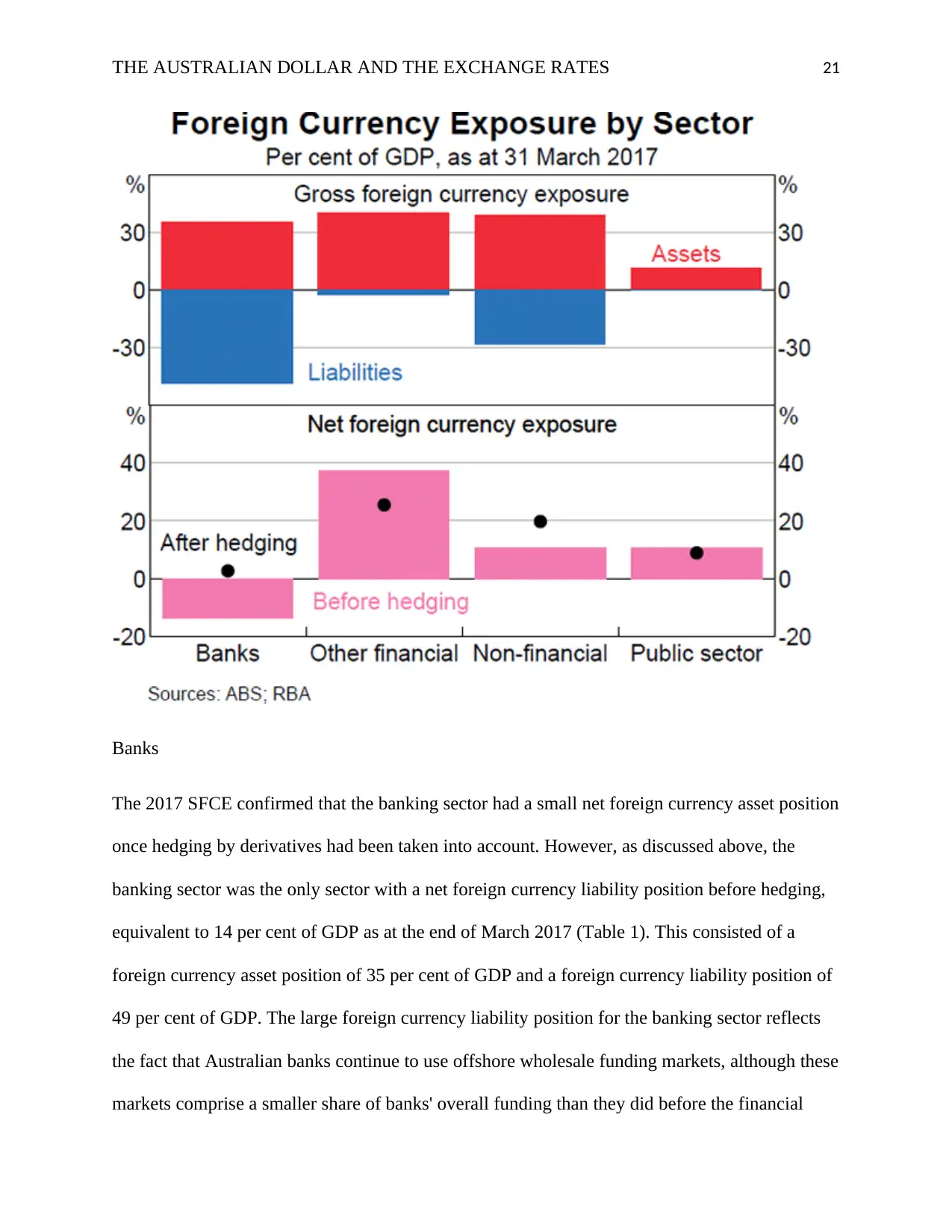
THE AUSTRALIAN DOLLAR AND THE EXCHANGE RATES 21
Banks
The 2017 SFCE confirmed that the banking sector had a small net foreign currency asset position
once hedging by derivatives had been taken into account. However, as discussed above, the
banking sector was the only sector with a net foreign currency liability position before hedging,
equivalent to 14 per cent of GDP as at the end of March 2017 (Table 1). This consisted of a
foreign currency asset position of 35 per cent of GDP and a foreign currency liability position of
49 per cent of GDP. The large foreign currency liability position for the banking sector reflects
the fact that Australian banks continue to use offshore wholesale funding markets, although these
markets comprise a smaller share of banks' overall funding than they did before the financial
Banks
The 2017 SFCE confirmed that the banking sector had a small net foreign currency asset position
once hedging by derivatives had been taken into account. However, as discussed above, the
banking sector was the only sector with a net foreign currency liability position before hedging,
equivalent to 14 per cent of GDP as at the end of March 2017 (Table 1). This consisted of a
foreign currency asset position of 35 per cent of GDP and a foreign currency liability position of
49 per cent of GDP. The large foreign currency liability position for the banking sector reflects
the fact that Australian banks continue to use offshore wholesale funding markets, although these
markets comprise a smaller share of banks' overall funding than they did before the financial
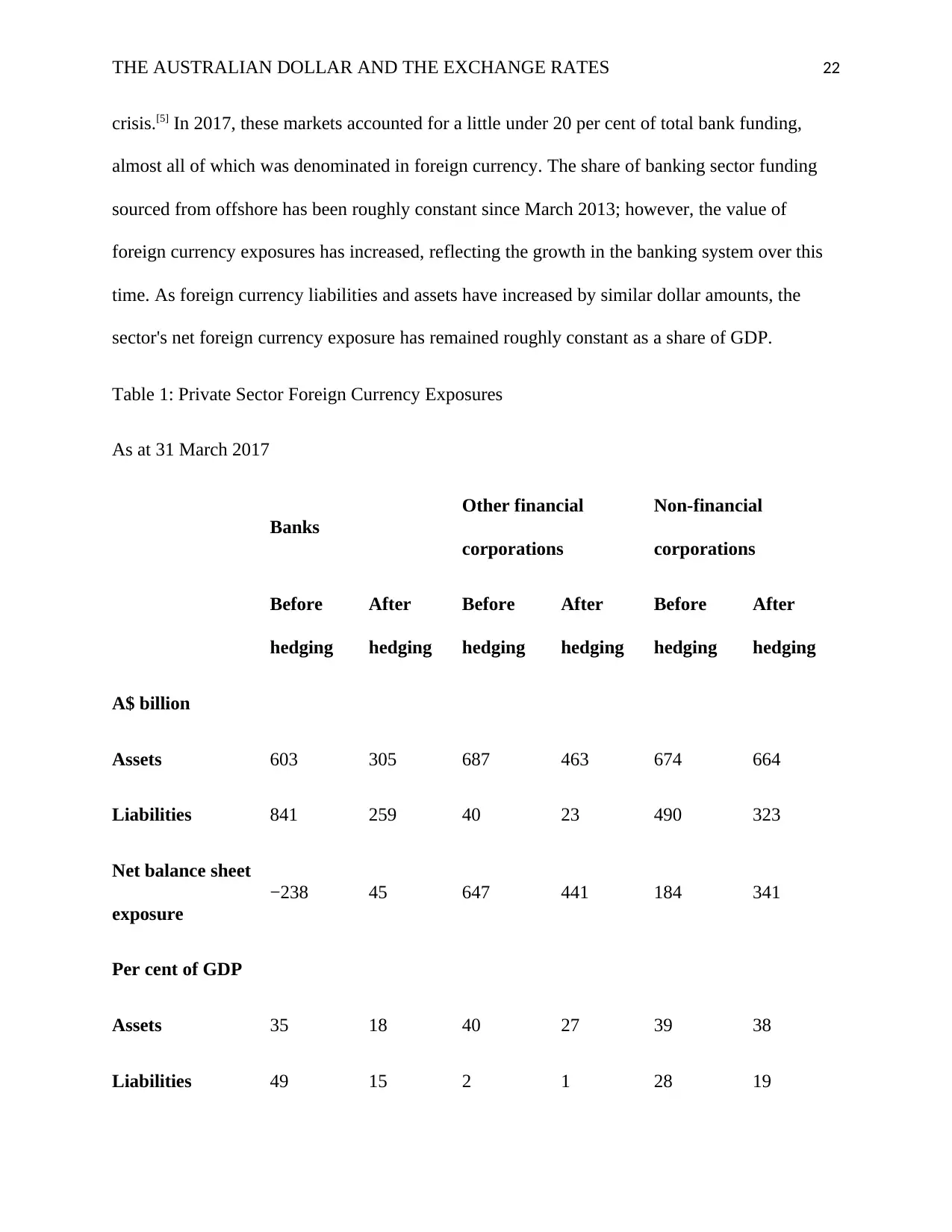
THE AUSTRALIAN DOLLAR AND THE EXCHANGE RATES 22
crisis.[5] In 2017, these markets accounted for a little under 20 per cent of total bank funding,
almost all of which was denominated in foreign currency. The share of banking sector funding
sourced from offshore has been roughly constant since March 2013; however, the value of
foreign currency exposures has increased, reflecting the growth in the banking system over this
time. As foreign currency liabilities and assets have increased by similar dollar amounts, the
sector's net foreign currency exposure has remained roughly constant as a share of GDP.
Table 1: Private Sector Foreign Currency Exposures
As at 31 March 2017
Banks
Other financial
corporations
Non-financial
corporations
Before
hedging
After
hedging
Before
hedging
After
hedging
Before
hedging
After
hedging
A$ billion
Assets 603 305 687 463 674 664
Liabilities 841 259 40 23 490 323
Net balance sheet
exposure
−238 45 647 441 184 341
Per cent of GDP
Assets 35 18 40 27 39 38
Liabilities 49 15 2 1 28 19
crisis.[5] In 2017, these markets accounted for a little under 20 per cent of total bank funding,
almost all of which was denominated in foreign currency. The share of banking sector funding
sourced from offshore has been roughly constant since March 2013; however, the value of
foreign currency exposures has increased, reflecting the growth in the banking system over this
time. As foreign currency liabilities and assets have increased by similar dollar amounts, the
sector's net foreign currency exposure has remained roughly constant as a share of GDP.
Table 1: Private Sector Foreign Currency Exposures
As at 31 March 2017
Banks
Other financial
corporations
Non-financial
corporations
Before
hedging
After
hedging
Before
hedging
After
hedging
Before
hedging
After
hedging
A$ billion
Assets 603 305 687 463 674 664
Liabilities 841 259 40 23 490 323
Net balance sheet
exposure
−238 45 647 441 184 341
Per cent of GDP
Assets 35 18 40 27 39 38
Liabilities 49 15 2 1 28 19
Secure Best Marks with AI Grader
Need help grading? Try our AI Grader for instant feedback on your assignments.

THE AUSTRALIAN DOLLAR AND THE EXCHANGE RATES 23
Table 1: Private Sector Foreign Currency Exposures
As at 31 March 2017
Banks
Other financial
corporations
Non-financial
corporations
Before
hedging
After
hedging
Before
hedging
After
hedging
Before
hedging
After
hedging
Net balance sheet
exposure
−14 3 37 26 11 20
Sources: ABS; RBA
The change in banks' net foreign currency position after hedging by derivatives is taken into
account reflects the fact that banks explicitly hedge 70 per cent of their foreign currency
liabilities with derivatives, but only 50 per cent of their foreign currency assets. The overall net
foreign currency asset position means that hedging fully offsets the exposure to the exchange rate
risk that arises from the banks taking advantage of offshore markets to diversify their funding
mix.
Debt security liabilities are the main source of foreign currency exposure for the banking sector,
accounting for over half of the sector's foreign currency liabilities. The increase in banks' debt
security liabilities since the previous survey has been proportionate to the increase in total bank
balance sheets. The 2017 SFCE indicated that around 85 per cent of these liabilities were hedged
using derivatives, with hedging more prevalent for long-term debt securities than short-term ones
Table 1: Private Sector Foreign Currency Exposures
As at 31 March 2017
Banks
Other financial
corporations
Non-financial
corporations
Before
hedging
After
hedging
Before
hedging
After
hedging
Before
hedging
After
hedging
Net balance sheet
exposure
−14 3 37 26 11 20
Sources: ABS; RBA
The change in banks' net foreign currency position after hedging by derivatives is taken into
account reflects the fact that banks explicitly hedge 70 per cent of their foreign currency
liabilities with derivatives, but only 50 per cent of their foreign currency assets. The overall net
foreign currency asset position means that hedging fully offsets the exposure to the exchange rate
risk that arises from the banks taking advantage of offshore markets to diversify their funding
mix.
Debt security liabilities are the main source of foreign currency exposure for the banking sector,
accounting for over half of the sector's foreign currency liabilities. The increase in banks' debt
security liabilities since the previous survey has been proportionate to the increase in total bank
balance sheets. The 2017 SFCE indicated that around 85 per cent of these liabilities were hedged
using derivatives, with hedging more prevalent for long-term debt securities than short-term ones
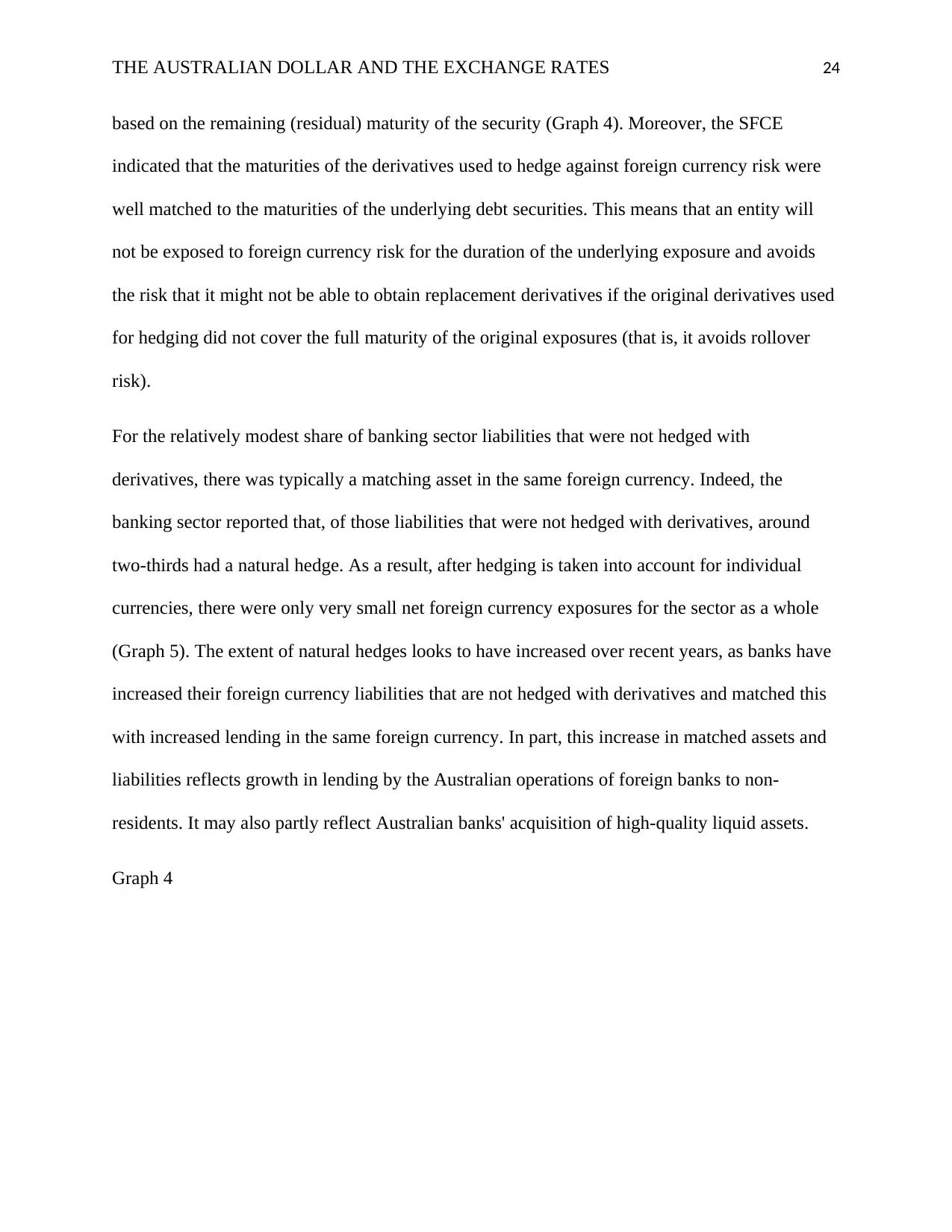
THE AUSTRALIAN DOLLAR AND THE EXCHANGE RATES 24
based on the remaining (residual) maturity of the security (Graph 4). Moreover, the SFCE
indicated that the maturities of the derivatives used to hedge against foreign currency risk were
well matched to the maturities of the underlying debt securities. This means that an entity will
not be exposed to foreign currency risk for the duration of the underlying exposure and avoids
the risk that it might not be able to obtain replacement derivatives if the original derivatives used
for hedging did not cover the full maturity of the original exposures (that is, it avoids rollover
risk).
For the relatively modest share of banking sector liabilities that were not hedged with
derivatives, there was typically a matching asset in the same foreign currency. Indeed, the
banking sector reported that, of those liabilities that were not hedged with derivatives, around
two-thirds had a natural hedge. As a result, after hedging is taken into account for individual
currencies, there were only very small net foreign currency exposures for the sector as a whole
(Graph 5). The extent of natural hedges looks to have increased over recent years, as banks have
increased their foreign currency liabilities that are not hedged with derivatives and matched this
with increased lending in the same foreign currency. In part, this increase in matched assets and
liabilities reflects growth in lending by the Australian operations of foreign banks to non-
residents. It may also partly reflect Australian banks' acquisition of high-quality liquid assets.
Graph 4
based on the remaining (residual) maturity of the security (Graph 4). Moreover, the SFCE
indicated that the maturities of the derivatives used to hedge against foreign currency risk were
well matched to the maturities of the underlying debt securities. This means that an entity will
not be exposed to foreign currency risk for the duration of the underlying exposure and avoids
the risk that it might not be able to obtain replacement derivatives if the original derivatives used
for hedging did not cover the full maturity of the original exposures (that is, it avoids rollover
risk).
For the relatively modest share of banking sector liabilities that were not hedged with
derivatives, there was typically a matching asset in the same foreign currency. Indeed, the
banking sector reported that, of those liabilities that were not hedged with derivatives, around
two-thirds had a natural hedge. As a result, after hedging is taken into account for individual
currencies, there were only very small net foreign currency exposures for the sector as a whole
(Graph 5). The extent of natural hedges looks to have increased over recent years, as banks have
increased their foreign currency liabilities that are not hedged with derivatives and matched this
with increased lending in the same foreign currency. In part, this increase in matched assets and
liabilities reflects growth in lending by the Australian operations of foreign banks to non-
residents. It may also partly reflect Australian banks' acquisition of high-quality liquid assets.
Graph 4
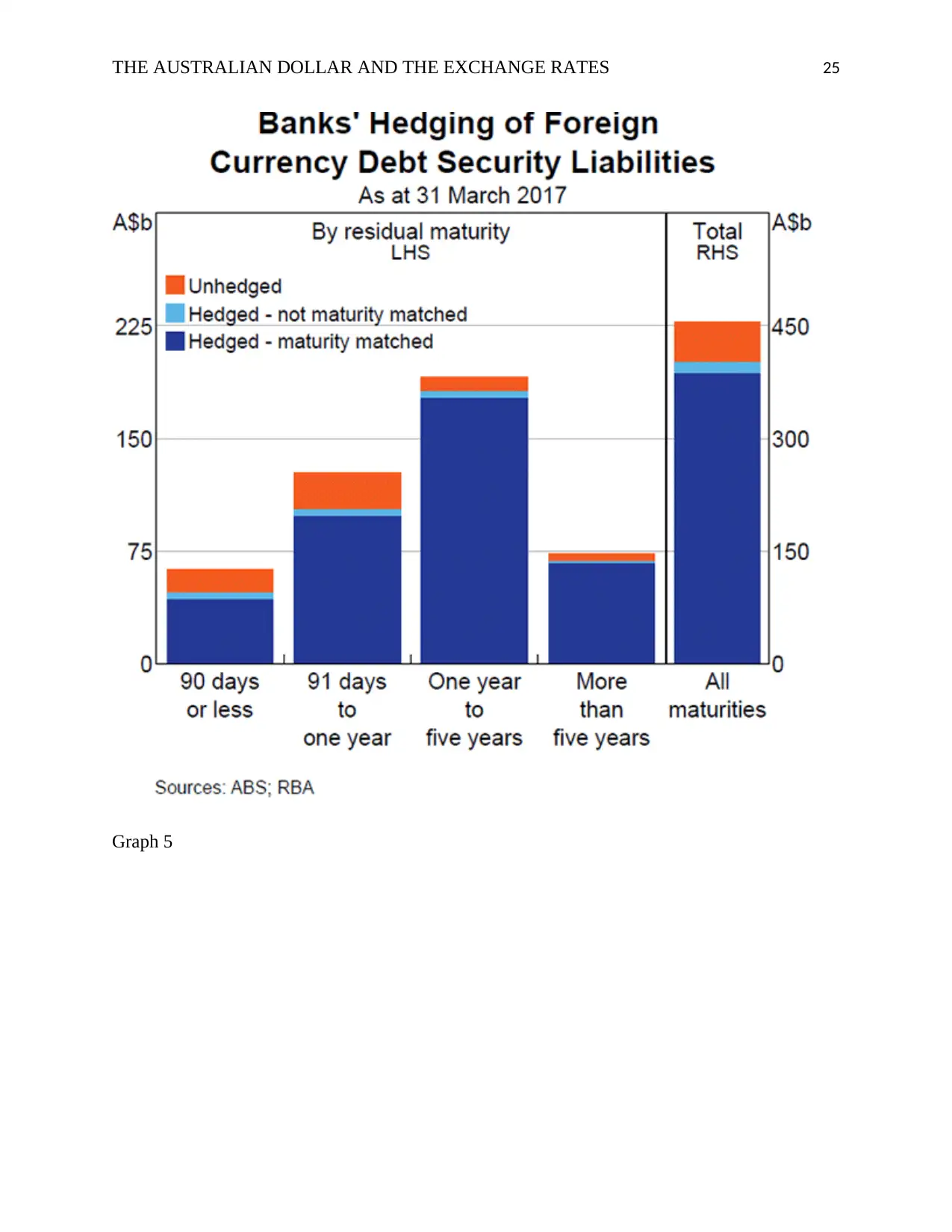
THE AUSTRALIAN DOLLAR AND THE EXCHANGE RATES 25
Graph 5
Graph 5
Paraphrase This Document
Need a fresh take? Get an instant paraphrase of this document with our AI Paraphraser

THE AUSTRALIAN DOLLAR AND THE EXCHANGE RATES 26
Other financial corporations
The other financial corporations sector includes non-bank financial corporations, including
superannuation funds, fund managers and insurance corporations.[6] These entities generally
invest on behalf of households and other firms with the aim of providing high risk-adjusted
returns. These firms seek to diversify their investment portfolios by holding a variety of assets
including foreign equities and assets that pay a fixed income, such as government and corporate
bonds. For example, foreign equities represented 45 per cent of superannuation funds' equity
Other financial corporations
The other financial corporations sector includes non-bank financial corporations, including
superannuation funds, fund managers and insurance corporations.[6] These entities generally
invest on behalf of households and other firms with the aim of providing high risk-adjusted
returns. These firms seek to diversify their investment portfolios by holding a variety of assets
including foreign equities and assets that pay a fixed income, such as government and corporate
bonds. For example, foreign equities represented 45 per cent of superannuation funds' equity
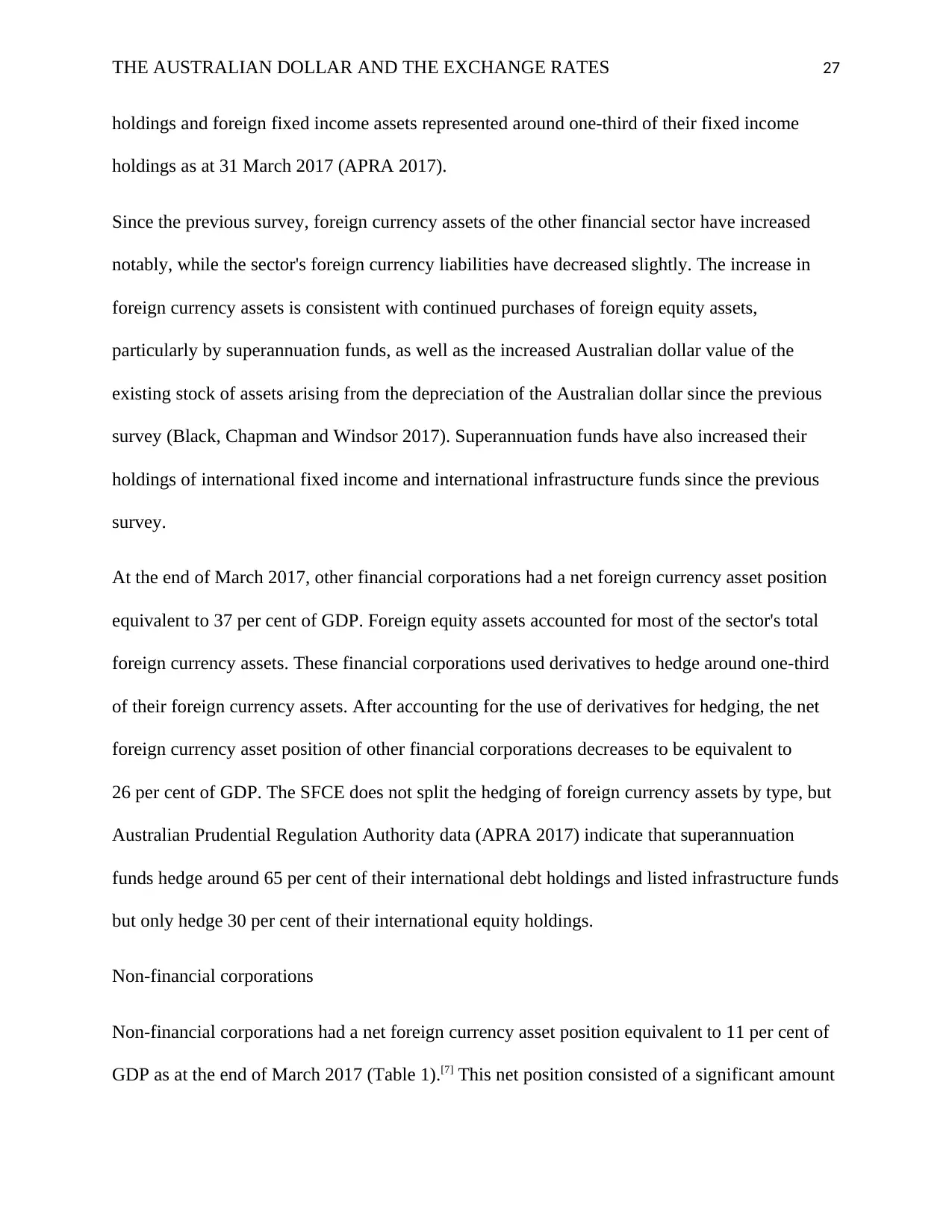
THE AUSTRALIAN DOLLAR AND THE EXCHANGE RATES 27
holdings and foreign fixed income assets represented around one-third of their fixed income
holdings as at 31 March 2017 (APRA 2017).
Since the previous survey, foreign currency assets of the other financial sector have increased
notably, while the sector's foreign currency liabilities have decreased slightly. The increase in
foreign currency assets is consistent with continued purchases of foreign equity assets,
particularly by superannuation funds, as well as the increased Australian dollar value of the
existing stock of assets arising from the depreciation of the Australian dollar since the previous
survey (Black, Chapman and Windsor 2017). Superannuation funds have also increased their
holdings of international fixed income and international infrastructure funds since the previous
survey.
At the end of March 2017, other financial corporations had a net foreign currency asset position
equivalent to 37 per cent of GDP. Foreign equity assets accounted for most of the sector's total
foreign currency assets. These financial corporations used derivatives to hedge around one-third
of their foreign currency assets. After accounting for the use of derivatives for hedging, the net
foreign currency asset position of other financial corporations decreases to be equivalent to
26 per cent of GDP. The SFCE does not split the hedging of foreign currency assets by type, but
Australian Prudential Regulation Authority data (APRA 2017) indicate that superannuation
funds hedge around 65 per cent of their international debt holdings and listed infrastructure funds
but only hedge 30 per cent of their international equity holdings.
Non-financial corporations
Non-financial corporations had a net foreign currency asset position equivalent to 11 per cent of
GDP as at the end of March 2017 (Table 1).[7] This net position consisted of a significant amount
holdings and foreign fixed income assets represented around one-third of their fixed income
holdings as at 31 March 2017 (APRA 2017).
Since the previous survey, foreign currency assets of the other financial sector have increased
notably, while the sector's foreign currency liabilities have decreased slightly. The increase in
foreign currency assets is consistent with continued purchases of foreign equity assets,
particularly by superannuation funds, as well as the increased Australian dollar value of the
existing stock of assets arising from the depreciation of the Australian dollar since the previous
survey (Black, Chapman and Windsor 2017). Superannuation funds have also increased their
holdings of international fixed income and international infrastructure funds since the previous
survey.
At the end of March 2017, other financial corporations had a net foreign currency asset position
equivalent to 37 per cent of GDP. Foreign equity assets accounted for most of the sector's total
foreign currency assets. These financial corporations used derivatives to hedge around one-third
of their foreign currency assets. After accounting for the use of derivatives for hedging, the net
foreign currency asset position of other financial corporations decreases to be equivalent to
26 per cent of GDP. The SFCE does not split the hedging of foreign currency assets by type, but
Australian Prudential Regulation Authority data (APRA 2017) indicate that superannuation
funds hedge around 65 per cent of their international debt holdings and listed infrastructure funds
but only hedge 30 per cent of their international equity holdings.
Non-financial corporations
Non-financial corporations had a net foreign currency asset position equivalent to 11 per cent of
GDP as at the end of March 2017 (Table 1).[7] This net position consisted of a significant amount

THE AUSTRALIAN DOLLAR AND THE EXCHANGE RATES 28
of foreign currency assets, around two-thirds of which were equity assets.[8] However, the sector
also had a significant amount of foreign currency liabilities, almost all of which were either long-
term debt securities or loans. The sector's asset and liability positions were noticeably larger in
2017 than in the previous survey. This growth partly reflects valuation effects from the
Australian dollar depreciation and, for assets, the performance of foreign equities. After
accounting for the use of derivatives to hedge, non-financial corporations had a net foreign
currency asset position of 20 per cent of GDP at the end of March 2017.
Non-financial corporations do not use derivatives for hedging as much as other sectors. The 2017
SFCE indicated that derivatives were used to hedge only around one-third of their foreign
currency liabilities and a negligible amount of the foreign currency assets. This difference is
related to the composition of the sectors' assets and liabilities. The foreign currency equity assets
of the sector include the foreign operations (subsidiaries and branches) of multinational
corporations, which are offset by foreign currency borrowing in the form of loans and debt
securities. In addition, some non-financial corporations conduct much of their trade in foreign
currency, so foreign currency borrowing is matched to trade payments. For example, a large
share of Australia's resource exports is invoiced in US dollars (ABS 2016). Mining firms
generally borrow in US dollars to match the currency of their debt payment obligations to these
trade receipts.
Changes to cash flows arising from exchange rate movements affect trade payment and receipts,
and are a potential source of vulnerability for non-financial corporates. This is important because
a large share of Australia's exports is invoiced in foreign currency. Non-financial corporations
represent almost all of Australia's expected foreign currency trade receipts and a vast majority of
Australia's expected foreign currency trade payments.[9] Hedging of these flows by derivatives is
of foreign currency assets, around two-thirds of which were equity assets.[8] However, the sector
also had a significant amount of foreign currency liabilities, almost all of which were either long-
term debt securities or loans. The sector's asset and liability positions were noticeably larger in
2017 than in the previous survey. This growth partly reflects valuation effects from the
Australian dollar depreciation and, for assets, the performance of foreign equities. After
accounting for the use of derivatives to hedge, non-financial corporations had a net foreign
currency asset position of 20 per cent of GDP at the end of March 2017.
Non-financial corporations do not use derivatives for hedging as much as other sectors. The 2017
SFCE indicated that derivatives were used to hedge only around one-third of their foreign
currency liabilities and a negligible amount of the foreign currency assets. This difference is
related to the composition of the sectors' assets and liabilities. The foreign currency equity assets
of the sector include the foreign operations (subsidiaries and branches) of multinational
corporations, which are offset by foreign currency borrowing in the form of loans and debt
securities. In addition, some non-financial corporations conduct much of their trade in foreign
currency, so foreign currency borrowing is matched to trade payments. For example, a large
share of Australia's resource exports is invoiced in US dollars (ABS 2016). Mining firms
generally borrow in US dollars to match the currency of their debt payment obligations to these
trade receipts.
Changes to cash flows arising from exchange rate movements affect trade payment and receipts,
and are a potential source of vulnerability for non-financial corporates. This is important because
a large share of Australia's exports is invoiced in foreign currency. Non-financial corporations
represent almost all of Australia's expected foreign currency trade receipts and a vast majority of
Australia's expected foreign currency trade payments.[9] Hedging of these flows by derivatives is
Secure Best Marks with AI Grader
Need help grading? Try our AI Grader for instant feedback on your assignments.

THE AUSTRALIAN DOLLAR AND THE EXCHANGE RATES 29
low. At the end of March 2017, non-financial corporations used derivatives to hedge around one-
fifth of their foreign currency trade payments and around 15 per cent of their trade receipts
(Graph 6). After accounting for the use of derivatives, the sector had around $350 billion in
expected trade receipts and $250 billion in expected trade payments over the next four years.
Graph 6
Public sector
low. At the end of March 2017, non-financial corporations used derivatives to hedge around one-
fifth of their foreign currency trade payments and around 15 per cent of their trade receipts
(Graph 6). After accounting for the use of derivatives, the sector had around $350 billion in
expected trade receipts and $250 billion in expected trade payments over the next four years.
Graph 6
Public sector
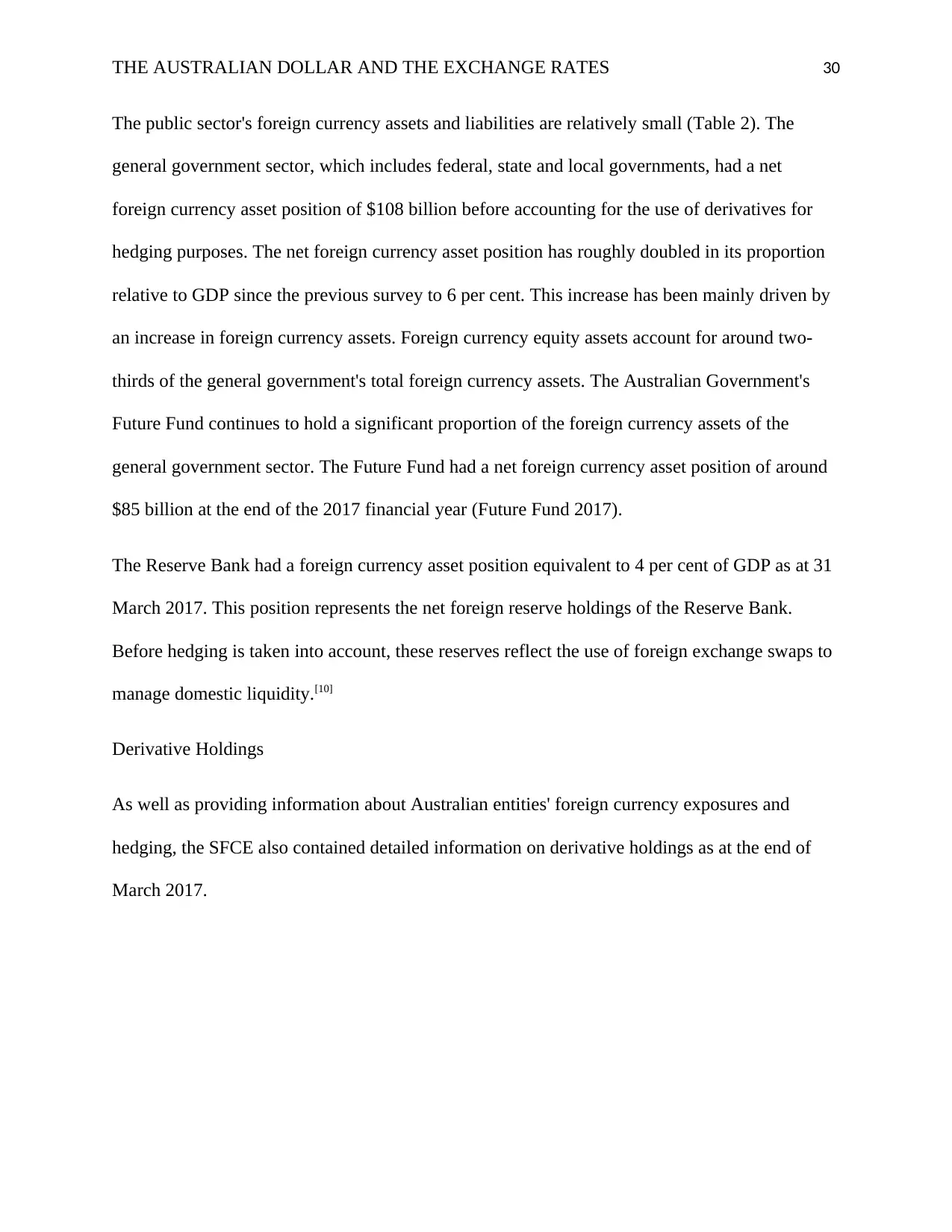
THE AUSTRALIAN DOLLAR AND THE EXCHANGE RATES 30
The public sector's foreign currency assets and liabilities are relatively small (Table 2). The
general government sector, which includes federal, state and local governments, had a net
foreign currency asset position of $108 billion before accounting for the use of derivatives for
hedging purposes. The net foreign currency asset position has roughly doubled in its proportion
relative to GDP since the previous survey to 6 per cent. This increase has been mainly driven by
an increase in foreign currency assets. Foreign currency equity assets account for around two-
thirds of the general government's total foreign currency assets. The Australian Government's
Future Fund continues to hold a significant proportion of the foreign currency assets of the
general government sector. The Future Fund had a net foreign currency asset position of around
$85 billion at the end of the 2017 financial year (Future Fund 2017).
The Reserve Bank had a foreign currency asset position equivalent to 4 per cent of GDP as at 31
March 2017. This position represents the net foreign reserve holdings of the Reserve Bank.
Before hedging is taken into account, these reserves reflect the use of foreign exchange swaps to
manage domestic liquidity.[10]
Derivative Holdings
As well as providing information about Australian entities' foreign currency exposures and
hedging, the SFCE also contained detailed information on derivative holdings as at the end of
March 2017.
The public sector's foreign currency assets and liabilities are relatively small (Table 2). The
general government sector, which includes federal, state and local governments, had a net
foreign currency asset position of $108 billion before accounting for the use of derivatives for
hedging purposes. The net foreign currency asset position has roughly doubled in its proportion
relative to GDP since the previous survey to 6 per cent. This increase has been mainly driven by
an increase in foreign currency assets. Foreign currency equity assets account for around two-
thirds of the general government's total foreign currency assets. The Australian Government's
Future Fund continues to hold a significant proportion of the foreign currency assets of the
general government sector. The Future Fund had a net foreign currency asset position of around
$85 billion at the end of the 2017 financial year (Future Fund 2017).
The Reserve Bank had a foreign currency asset position equivalent to 4 per cent of GDP as at 31
March 2017. This position represents the net foreign reserve holdings of the Reserve Bank.
Before hedging is taken into account, these reserves reflect the use of foreign exchange swaps to
manage domestic liquidity.[10]
Derivative Holdings
As well as providing information about Australian entities' foreign currency exposures and
hedging, the SFCE also contained detailed information on derivative holdings as at the end of
March 2017.
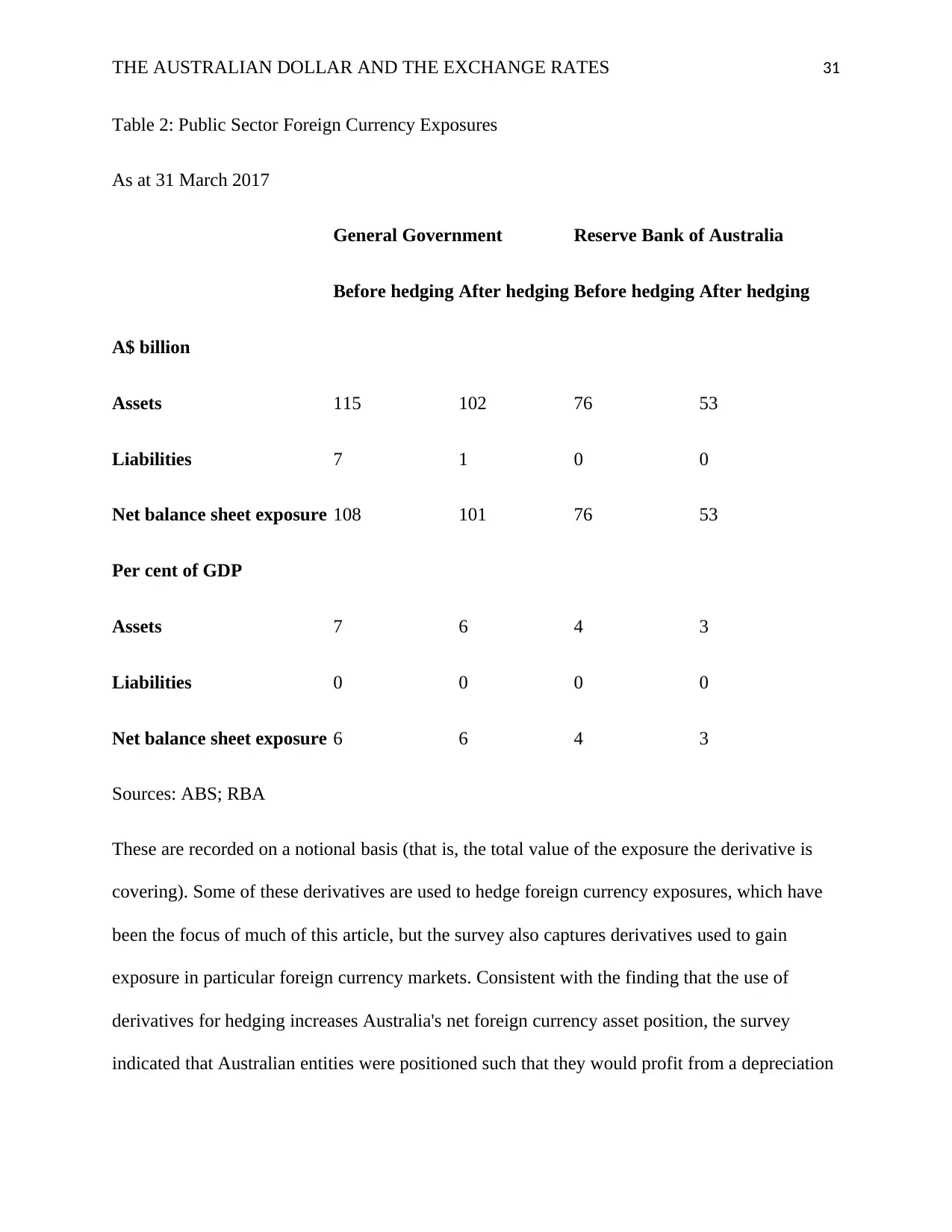
THE AUSTRALIAN DOLLAR AND THE EXCHANGE RATES 31
Table 2: Public Sector Foreign Currency Exposures
As at 31 March 2017
General Government Reserve Bank of Australia
Before hedging After hedging Before hedging After hedging
A$ billion
Assets 115 102 76 53
Liabilities 7 1 0 0
Net balance sheet exposure 108 101 76 53
Per cent of GDP
Assets 7 6 4 3
Liabilities 0 0 0 0
Net balance sheet exposure 6 6 4 3
Sources: ABS; RBA
These are recorded on a notional basis (that is, the total value of the exposure the derivative is
covering). Some of these derivatives are used to hedge foreign currency exposures, which have
been the focus of much of this article, but the survey also captures derivatives used to gain
exposure in particular foreign currency markets. Consistent with the finding that the use of
derivatives for hedging increases Australia's net foreign currency asset position, the survey
indicated that Australian entities were positioned such that they would profit from a depreciation
Table 2: Public Sector Foreign Currency Exposures
As at 31 March 2017
General Government Reserve Bank of Australia
Before hedging After hedging Before hedging After hedging
A$ billion
Assets 115 102 76 53
Liabilities 7 1 0 0
Net balance sheet exposure 108 101 76 53
Per cent of GDP
Assets 7 6 4 3
Liabilities 0 0 0 0
Net balance sheet exposure 6 6 4 3
Sources: ABS; RBA
These are recorded on a notional basis (that is, the total value of the exposure the derivative is
covering). Some of these derivatives are used to hedge foreign currency exposures, which have
been the focus of much of this article, but the survey also captures derivatives used to gain
exposure in particular foreign currency markets. Consistent with the finding that the use of
derivatives for hedging increases Australia's net foreign currency asset position, the survey
indicated that Australian entities were positioned such that they would profit from a depreciation
Paraphrase This Document
Need a fresh take? Get an instant paraphrase of this document with our AI Paraphraser

THE AUSTRALIAN DOLLAR AND THE EXCHANGE RATES 32
of the Australian dollar (that is, they had a net short Australian dollar position or a net long
foreign currency position against non-residents) (Graph 7).
Cross-currency swaps continue to be the main instrument used to hedge foreign currency
exposures; holdings of these instruments are concentrated in the banking sector.[11] Cross-
currency swaps, which are generally used to hedge longer-term foreign currency risk, accounted
for slightly more than two-thirds of total notional long foreign currency positions (or short
Australian dollar positions) and around half of short foreign currency derivative positions (or
long Australian dollar positions). Forwards, which are generally used to hedge shorter-term
foreign currency risk, accounted for most of the remainder of the positions. These shares were
relatively unchanged from the previous survey, in line with relative stability in the maturity of
banks' new offshore wholesale funding over this period. The shares had increased noticeably in
the four years before the previous survey (Arsov et al 2013).
Graph 7
of the Australian dollar (that is, they had a net short Australian dollar position or a net long
foreign currency position against non-residents) (Graph 7).
Cross-currency swaps continue to be the main instrument used to hedge foreign currency
exposures; holdings of these instruments are concentrated in the banking sector.[11] Cross-
currency swaps, which are generally used to hedge longer-term foreign currency risk, accounted
for slightly more than two-thirds of total notional long foreign currency positions (or short
Australian dollar positions) and around half of short foreign currency derivative positions (or
long Australian dollar positions). Forwards, which are generally used to hedge shorter-term
foreign currency risk, accounted for most of the remainder of the positions. These shares were
relatively unchanged from the previous survey, in line with relative stability in the maturity of
banks' new offshore wholesale funding over this period. The shares had increased noticeably in
the four years before the previous survey (Arsov et al 2013).
Graph 7
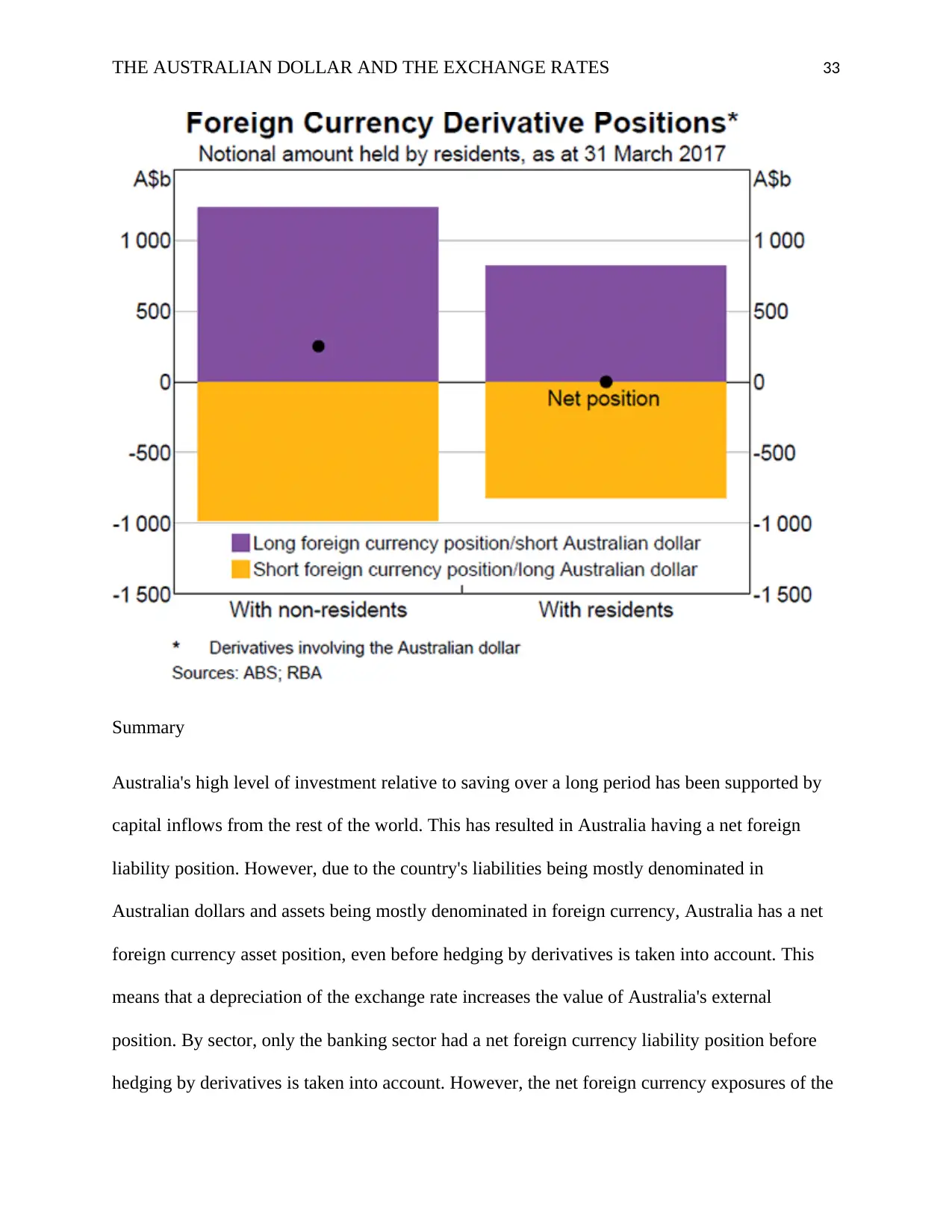
THE AUSTRALIAN DOLLAR AND THE EXCHANGE RATES 33
Summary
Australia's high level of investment relative to saving over a long period has been supported by
capital inflows from the rest of the world. This has resulted in Australia having a net foreign
liability position. However, due to the country's liabilities being mostly denominated in
Australian dollars and assets being mostly denominated in foreign currency, Australia has a net
foreign currency asset position, even before hedging by derivatives is taken into account. This
means that a depreciation of the exchange rate increases the value of Australia's external
position. By sector, only the banking sector had a net foreign currency liability position before
hedging by derivatives is taken into account. However, the net foreign currency exposures of the
Summary
Australia's high level of investment relative to saving over a long period has been supported by
capital inflows from the rest of the world. This has resulted in Australia having a net foreign
liability position. However, due to the country's liabilities being mostly denominated in
Australian dollars and assets being mostly denominated in foreign currency, Australia has a net
foreign currency asset position, even before hedging by derivatives is taken into account. This
means that a depreciation of the exchange rate increases the value of Australia's external
position. By sector, only the banking sector had a net foreign currency liability position before
hedging by derivatives is taken into account. However, the net foreign currency exposures of the
1 out of 33
Related Documents
Your All-in-One AI-Powered Toolkit for Academic Success.
+13062052269
info@desklib.com
Available 24*7 on WhatsApp / Email
![[object Object]](/_next/static/media/star-bottom.7253800d.svg)
Unlock your academic potential
© 2024 | Zucol Services PVT LTD | All rights reserved.





